#as if i expect every Western film to be well-written ha
Note
Industry question for you, please: Why is it that it seems that Thai BL in particular has some really systemic issues with writing endings? Screwed-up pacing/editing, out-of-character/illogical actions, not being very satisfying... it seems like a show avoiding that fate is more of an exception than the rule, unfortunately. Do a lot of them just... not write the ending ahead of time? 😅 That would make having these sort of wacked-up endings at least make some sense, but... really, it makes *no* sense to me that that would be the actual standard writing strategy-- I mean, for example, one of the best living novel authors I know of *always* has very satisfying endings, literally without fail (I have read everything he's written and been perfectly content with the ending of every one), and the reason for that is he purposefully always writes the endings of his books *first*, then works everything back up to that point. Similarly, some of the best TV shows I've seen (from any country-- and this does actually include some Thai ones, to be fair) were written either all in one go or at the *very* least with their endings obviously already very firmly in mind, regardless of if they were completely original or were adaptations of some other source material. So... why does this often seem to be such a difficulty for the writers of Thai BL? 😅 (Sorry if I sound a little salty here, but endings either make or break all fiction for me {novels, manga/manhwa, TV, movies, games, whatever}, and I've been getting burned what seems to be more and more often lately with shows being great for the vast majority of their runtime but then inexplicably totally botching the landing, seemingly out of nowhere-- so I'm a bit frustrated with that when it seems to be a really simply-solved problem {that, indeed, has already been solved by many others before}: JUST WRITE THE DAMN ENDING *FIRST* and then work up to it? 🙃😅)
Endings huh? You a romance reader by nature? (Wait, no, you said... HE. So... Sparks? Green?) Anygay, where was I?
But yeah, I get it. I've always fancied the dessert course the most, myself.
To answer your question, not sure. I'm assuming its a narrative expectation based in culture. Like Japan and their lanes, China and 6 act structure, or Korea's adoration of love triangles. And producing culture comes to film and storytelling with its own set narrative conceits, archetypes, and tropes and aren't proscriptive but are leaned on a lot. Much as they come to film with a certain style as well.
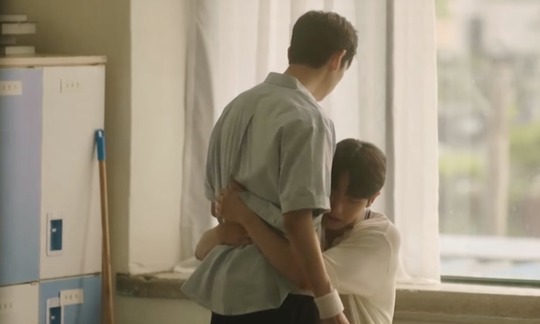

Think about the "look" of Korean BL compared to the "look" of Taiwanese BL, for example. They have an entirely different flavor to them. Korean stuff is usually all bright and airy, lots of distance shots, super clean and uncluttered, filtered and filmy and atmospheric. Taiwanese stuff is much closer, more grainy, more bold with it's color choices and contrasts, kind-up n your face and gritty, a bit messy sometimes.
It's jarring to go from one to the other.
After watching nothing but Asian dramas for so long, I always find it jarring to go back to American shit. It feels over-acted and unsubtle and kind of brash. Over all "loud" and in my face. Jarring.
So when first encountering 4 or 6 act structure most westerners feel a little unmoored, it doesn't feel comfortable until you sink into it and leave 3 & 5 behind.
I'm mean I'm so used to K-dramas with that arbitrary year or more separation in the final episode I;m now shocked when it's not there.
I guess what I'm saying is maybe it's just a thing with Thailand, not to put that much truck in endings. The way (especially) romances do in the western world. There's a very fixed idea of what an HEA should look like in the west. Thailand may not share that idea.
I've not read the source books of any of these BLs, so I don't know if this is just their narrative style or not.
I mean there are some Thai BLs with good (if not great) endings, and plenty of Korean BLs with terrible middles, and far too many Taiwanese BLs with bad beginnings.
Ya just kinda get used to it, I guess.
15 Thai BLs with Good Endings
A Tale of Thousand Stars
Bad Buddy
Lovely Writer
2gether
Be My Favorite
Dark Blue Kiss (possibly my favorite on this list)
Destiny Seeker
Make a Wish
Naughty Babe
SOTUS
#asked and answered#sort of#stories represent culture#it;s the whole point#actually#thai bl#bad endings
38 notes
·
View notes
Text
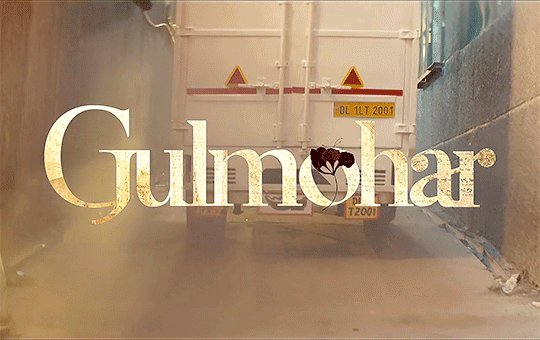
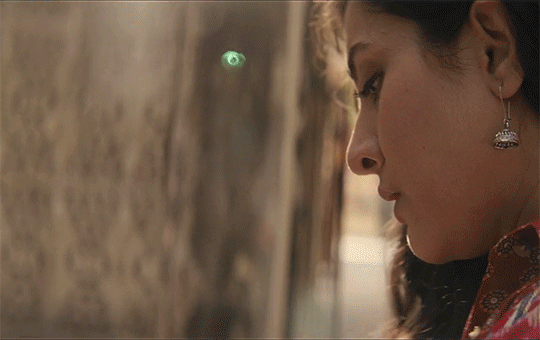



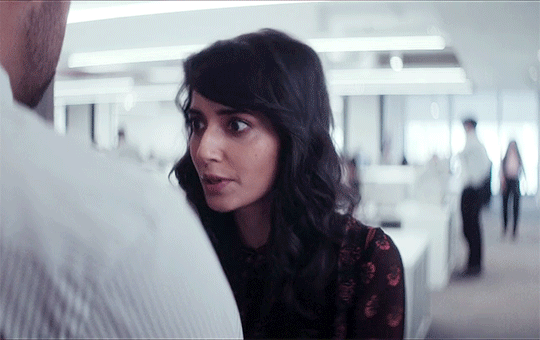
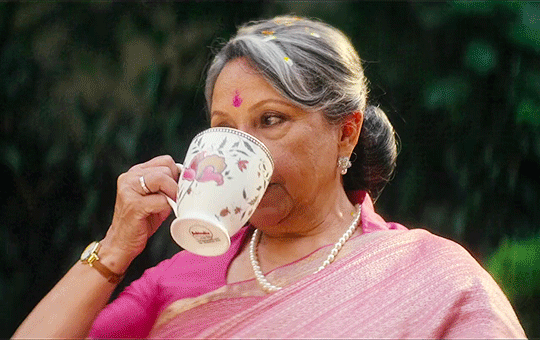
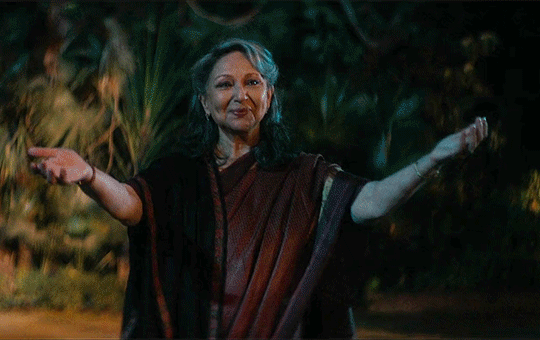

Every Film I Watch In 2023:
185. Gulmohar (2023)
#gulmohar#gulmohar (2023)#2023filmgifs#my gifs#that was so good holy shit#the script was so cohesive#with the motifs of boxes and rooms and secrets and scattered mess#i was like 'what the hell why isn't every desi film this well written'#as if i expect every Western film to be well-written ha#we always judge our own worst#and yes the first half of this was damn near triggering#esp with the nagging and the criticism#i almost had flashbacks ugh#but then my god the vulnerability#the devastating secrets#oof my heart#and yes i fully teared up at the end#also really beautifully shot#with the sunlight#and the rich colours#such an excellent cast#all of them were so good#which means it was excellent direction#also fuck yeah to Bollywood screen divas playing secret lesbians onscreen#i am HERE for this trend#queer film#queer desi film#even
22 notes
·
View notes
Text
No Cat Can Walk Out Of Her Own Story (Once Upon A Time In The Wastes)
To those who have read my posts before, you may have picked up on my complicated relationship with the concept of genre, in that I don’t really believe in it.
Don’t get me wrong, genre is definitely a thing, it just exists from the perspective of a reader, not a writer. Genre allows audiences to categorise their preferences, and allows librarians to categorise their catalogues. But from the angle of a writer, I find that trying to stick to a genre often leads to restrictions that limit creativity.
The tricky thing is, this is my opinion. Art is not science, and does not jell at all with ubiquitous statements. There is evidence to back up my claim, but at the same time, evidence that completely contradicts it. Funnily enough, She-Ra and the Princesses Of Power count as both, especially Once Upon a Time in the Waste.
Let me explain.
SPOILERS AHEAD (She-Ra and the Princesses Of Power)
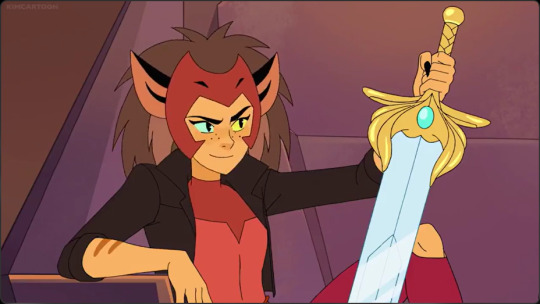
First, a few framing devices for this post.
I have been analysing the series as a whole through the lens of tragedy, which isn’t quite a genre, but it’s close enough that I feel the need to explain myself.
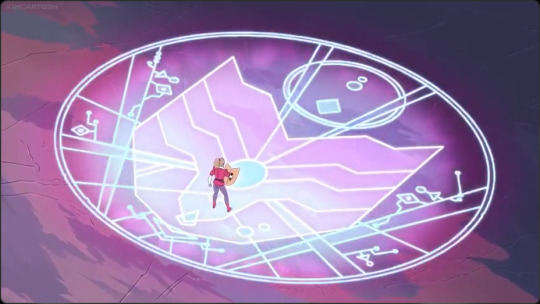
Tragedy is a vibe. It is an end goal for the story, a trajectory that it will try to hit. She-Ra is most definitely on this trajectory for most of its runtime, which plays into its themes of trauma and the cycle of abuse. The core question of the story is whether love will be enough to overpower that trajectory. Agency vs fate, like Romeo and Juliet.
A genre, meanwhile, is a collection of tropes, which can include a plot structure, but it doesn’t have to. They are different concepts that relate to each other, and overlap occasionally, but they are distinct.
Now, genre is, first and foremost, a literary tool. Tropes give expectations and implications, and often have meaning ascribed. So a story written in a specific genre can make use of that for its own purposes.
Part of the reason I am so chwit-chwat about my position on this is that I have a friend who excels at writing genre stories, and that has benefited their work immensely. Their ability to subvert expectations is predicated on the groundwork that they are writing within, that being the framework provided by each genre.

Cliches have a bad name, but there is genuinely a place for stories that are exactly what you expect. Not every art piece has to be thought provoking. Sometimes you just want to sit down, relax, and watch an adventure, and the Guardians of Ga’Hoole movie is engineered to suit your every need. If you want to think about what you are experiencing, read the Guardians of Ga’Hoole books, because they really play around with the genre.
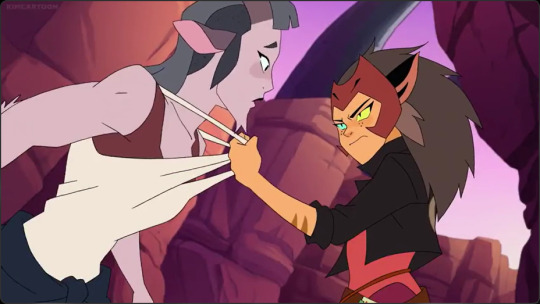
So, what is my point?
Well, I will come back to this at the end of the series, but I think She-Ra is on both ends of a spectrum, it can be classified as a ton of genres, but also none at all. Once Upon a Time in the Waste is a microcosm of this.
So, I’m going to argue here that this episode is a western story. As in, the archetype with lone wanderers and such. But I’m also going to argue that it isn’t.
Buckle up, this is going to get complicated.
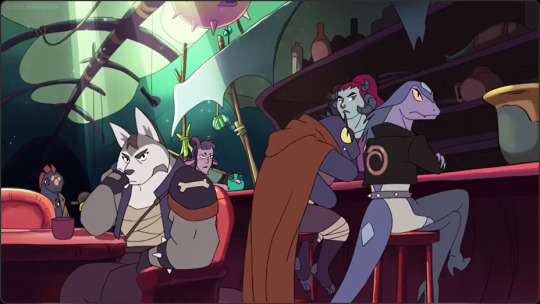
Westerns are technically just stories set in outback America in the late 1800s. But we can all agree that there is more to the genre than that. Duels at dawn, train heists, riding into the sunset. Think Rango, the third Back to the Future movie, and the 1960 version of The Magnificent Seven film. There is a framework to play around in.
The genre doesn’t so much carry the theme of freedom as collapse under its weight. Protagonists in these stories are usually on the run from the law, or seeking a new beginning, and plots have a tendency to bear a distinct anti-colonialist message. Mostly. The golden age of the genre was between 1940 and 1960, and modern writers have, for the most part, got better at writing this over time.
So, this episode has an implied theme of freedom, that goes with series as a whole’s discussion of agency. It also draws on the idea of a new beginning and the promise of an empty world. All it has to do is make itself clear, and it does this off the bat with two of the most western shots ever to western.
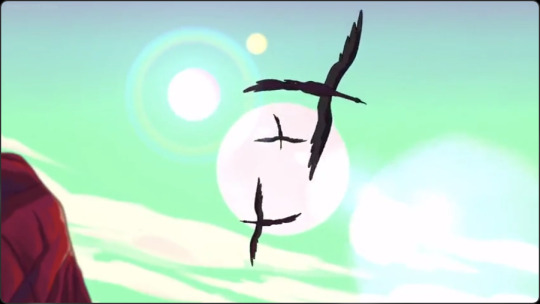
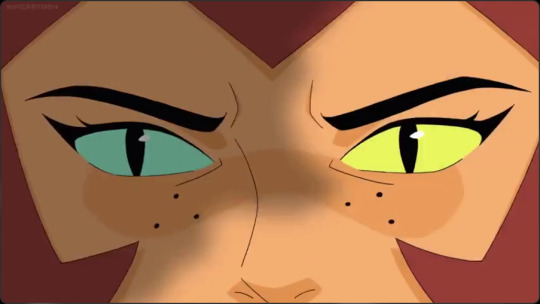
The amount that is being communicated by these two shots is astounding. Obviously, the vultures are circling Catra, and she’s watching them. Catra is aware that she is at rock bottom, and that death is closing in on her. Or at least, she thinks she is.
However, the worldbuilding element is there as well. Multiple moons instantly signals that this is a fantasy setting, and if you look closely, those aren’t actually vultures.
So, this is a western story with a bit of that fantastical flavour, right? Or is it a fantasy story with a bit of western flavour? Yes. The answer to both of those questions is “yes”.
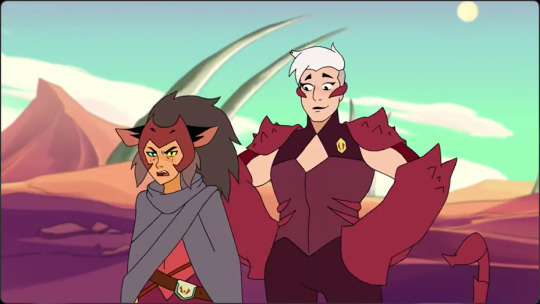
This episode is told from Catra’s perspective, and I think there is a bit of unreliable narration going on here. Not in the sense that events aren’t playing out as we see, but in the way that the cinematography surrounding those events influences us. This might not be a western story at all, those birds might have just found a column of air, but doom and gloom is what Catra sees, so it's what the audience sees.
On a side note, Catra’s dialogue in this episode is written like she has spent the last month listening to nothing but Linkin Park’s Crawling In My Skin on repeat. I have a deep love for angsty emo storytelling, but I think it is a stroke of genius to translate that exact energy into something so aesthetically at odds with being emo.
“You know what? It doesn't matter. Nothing matters anymore. You know what I see here? All my hard work, ignored because of one mistake. My dreams, turning to dust in front of my eyes. But mainly I'm looking at that?”
This is Catra’s first little speech of the episode, and she gets a few of these. Here, she is venting at Scorpia, which I will comment on in a bit, but it is important to note that Catra fully accepts responsibility for her fate. Yes, the world was against her, but she was the one who messed up. Which is interesting.
In my reading of this story, Catra has intellectually recognised that the Horde was abusive, but emotionally, not so much. She convinced herself that if she was perfect, she could just coast above, because the moments in-between the abuse were half decent. But that wasn't possible.
I feel it is important to understand that Catra doesn’t crave safety, she craves the feeling of being safe. She is chasing the high of security, and she was able to push through Shadow Weaver’s abuse and to ignore Hordack’s obvious red flags enough to obtain that feeling from authority. The high never lasted, but she has convinced herself that she could have made it work.
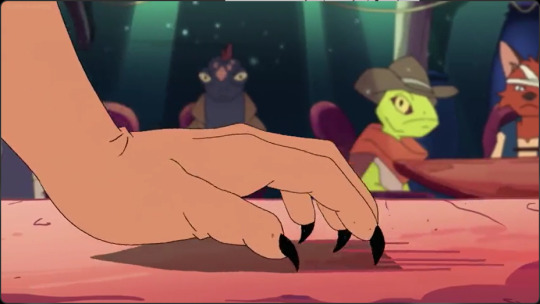
Back to the western thing. Protagonists in western stories are rarely good people, although they aren’t usually villainous. They are heroes, but their defining character trait is that they were capable enough to take control of the situation. Sometimes, they will save a village from some bandits, but half the time this is to save a love interest or because they have a grudge against the bandit leader or even just because the village pays well. Morality isn’t really a thing in western films.
In other words:
“There are only two rules in the Crimson Waste. One, the strong make the rules-”
(Laughing) “So, here's the thing. I've done this. The whole “threatening people” bit, the intimidation. I've been there. And I just don't care anymore.
Some people have a bad day. I've had a bad life. If I want something, it's taken from me. If I win a fight, I lose the war. Threats only work on someone who has something to lose. But me? I've already lost it all.
And you can't be any good at this, because you just let yourself get distracted.”
What I said about Catra from before works here as well. This also meshes rather nicely with the western protagonist. Catra has rocked up out of nowhere and demonstrated her capability.

However, that capability lies in force of personality, and in her allegiance with Scorpia, someone who exists to prove Catra wrong. Catra still has her friendship with Scorpia, and thats what this episode exists to show her.
This episode actually show Catra getting to be happy with herself and the world around her, because her worldview is rewarded. She has no higher authority, she can be mean in the way that the Horde has taught her to be, and it pays off.
Granted, it’s not exactly healthy, but it's better than what she had before.
So, Catra can feel safe, even in a place that is objectively more hostile to her than anywhere else. The ground tries to eat her, multiple times, but she is fine, she has her force of personality, and she has Scorpia.
“We make a good team, that's it.”
Scorpia makes Catra feel safe, she protects her, and she raises her up to make her own choices. The only other person that has done that, was Adora.
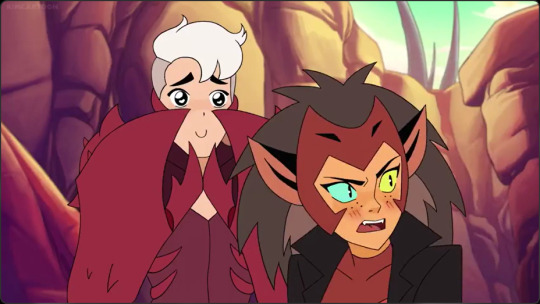
Before I continue, however, I feel the need to stress something. How Catra treated Scorpia up until this episode wasn’t great. It will get worse after this episode, and I will talk about that when I get there (If you know the show, you know which episode will prompt my full diagnoses), but for now, Catra hasn’t seen Scorpia as an equal until this point.
This is based on her upbringing. Whether you like her as a character or not, it is hard to disagree with the fact that Catra is mean. But that comes from a place of fear and of discomfort. Catra has no idea how to socialise with anyone, because she has never had a parental figure to show her. She was nice to Adora, and Adora left, so being nice was clearly not the right decision, in her mind.
On a similar note, it never occurs to Catra that anyone might like her. As in, she assumes at all times that people are trying to one up her or outmanoeuvre her. She was betrayed by Adora, in her mind, and Shadow Weaver never treated her with any dignity. Why would anyone help her? She has to force her way through everything.

Except, here is Scorpia. Scorpia, who offers a guiding hand to Catra to save her from the quicksand, even when it would be wiser to let Catra die and take over. Scorpia, who will follow Catra into the desert. Scorpia, who makes Catra feel safe and asks nothing in return.
The episode even gets in the duel at midday and the standoff with the bandits, with the reward for victory being more underlings. Catra builds herself a support network.
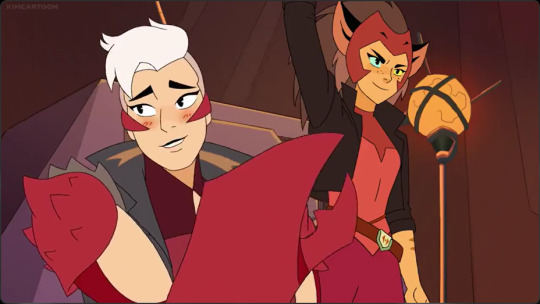
The sartorial detail of the jacket. Catra starts the episode clinging onto the cloak from the Horde. But it's too big for her. She then sheds it and steals the jacket when she starts fitting into the Horde and finding belonging. The jacket fits her perfectly, and she looks really good in it.
She then offers a similar jacket to Scorpia as a gesture of friendship. "I belong with you."
“A toast to driving Huntara out of the Waste!
A toast to finding all this new loot, huh?
And a toast to Boss Catra, best leader we've ever had!”
“Scorpia! A toast to Scorpia!”
So, about that new beginning then. I spoke at length in a previous post about how character development and allegiance relate to location. Adora changes location and can develop as a person. Shadow Weaver makes the exact same decision, and refuses to change, mostly. Now we have Catra, who has likewise shifted scenery, and she is making big strides in terms of relationships.
There are people who cheer her name unprompted, people who will keep her safe. This is everything she wants, right? Hold this thought.
Also, correct me if I’m wrong, but this is the first actively altruistic thing Catra has done. Yes, she shared the blanket, but that felt more like paying back a debt than actual kindness. This feels like growth, like Catra is finding a new place to start.
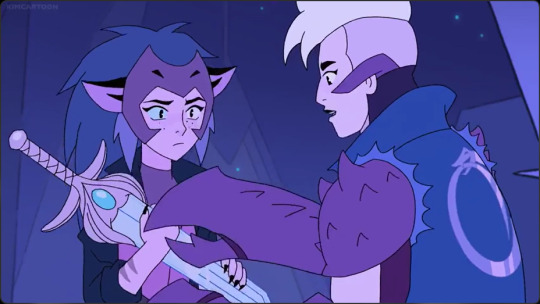
Catra's body language in this tiny scene is really well done. She starts off clutching the sword like a teddy bear, like she is taking comfort in having it. Then it falls to her side as Scorpia gets through to her and she subconsciously stops needing to have that victory.
“We've got the most important thing right here. You heard that hologram. This is the key to the whole planet. When I bring this back to the Fright Zone, Hordak will see me for what I'm worth and I'll be back on top.”
“Or, you know, counterpoint, we don't go back at all.”
“What? Why wouldn't we go back?”
“Uh... Because you hate it there?”
“I don't.”
“Hear me out, okay? Within like, a day, you've defeated the gangs ruling the Crimson Waste and made yourself their leader. This is the happiest I've ever seen you. Scratch that. This is the first time I've ever seen you happy, period. So, why would we go back? Let's stay here. Forget Hordak. Forget Adora. Forget all of them. We could rule the Crimson Waste together, just the two of us. We could, you know, be happy.”
“I… I don't… I have to go check on the prisoner.”
I think Catra actually considers this option. Again, the idea that her emotions and her thoughts are at separate levels of understanding comes back. But in a very real sense, this is what Catra wants, she has her life’s goal. So why can’t she stay?
For that, we need to talk about why Catra and Adora are such good foils.

Catra and Adora are the two tragic heroes of this story, but they exhibit their hamartia in completely opposite ways. For clarity, hamartia is another term for a heroic flaw, the thing that causes things to go wrong. She-Ra has a really interesting way of writing that, simplicity.
Every character in this story has a greatest strength that is also their greatest weakness. Glimmer is unyielding, which means her courage is second to none, but her adaptability is lessened. Huntara is both idealistic and cautious, when balanced these traits carry the crew, when unbalanced, these traits cause trouble.
Adora and Catra are opposites. Adora thinks incredibly quickly, which means that she is a remarkably good short-term tactician, but she struggles to think on the wider scale. Catra, meanwhile, is always planning five or six steps ahead of everyone else, but she can’t see the moment for what it is.
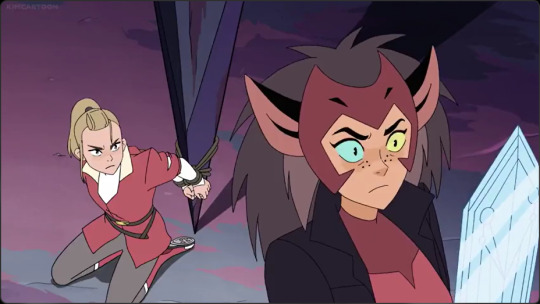
However, there is one more facet to these two, and it is the thing that joins them. Both Catra and Adora have a binary worldview. Something is either good or bad, someone is either a hero or a villain. Or, in Catra’s case, affection is exclusionary.
“Catra, Shadow Weaver is in Bright Moon.”
Catra is wounded by Shadow Weaver, more than she can possibly imagine. She wants to feel safe, and even while she is in the Crimson Wastes, she is not immune from her abuser’s ability to take away her security.
The news that Shadow Weaver is with Adora brings back all of Catra’s insecurities. It reminds Catra that she isn’t good enough, and that she can’t be safe. Most of all, it coalesces the two people who left Catra into one force, the Princess Alliance. Now, there is a single entity that Catra can fight, and her desire to feel safe means that she cannot think clearly until that entity is removed.
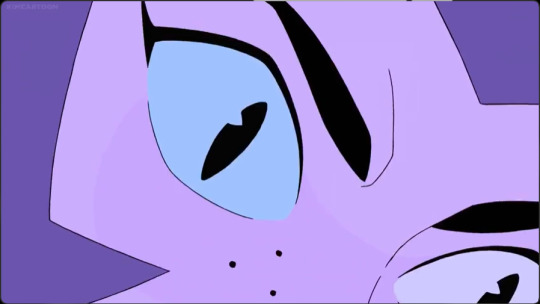
The final sequence of the episode is so unbelievably well written. The heavy breaths and deep, foreboding music drowning out everything. Pair that with the revisiting of the episode’s early shots, but this time with a Dutch tilt, and you have a sequence of a character in inner turmoil.

This could be a western story. This could be a tale of two outcasts seeking out a living in the vast wilderness, disappearing and being happy. But Catra can’t ride off into the sunset.
When Catra looks up, there are tears in her eyes, and the camera shifts to punctuate her words and decisions by zooming in, until all you can see are Catra’s eyes, and the tears that weigh them down.
Speaking of trauma, this episode is also the introduction of Mara, and that happens in a really interesting way.
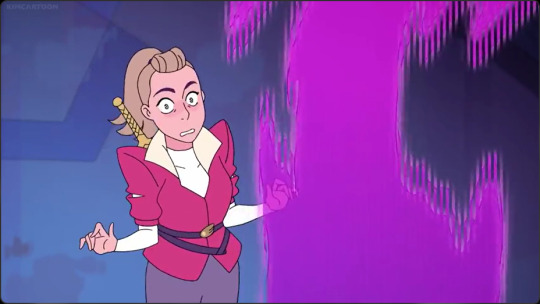
The comedy of Adora's wacky expression in this shot is pulling double duty here. It's funny, but its emphasising the fact that Adora's apparent success in finding answers is being undercut.
“Of course it's on a loop. Of course it is. Because why would a hologram ever give me a straight answer? Solve a puzzle. Train. Let go. I do everything they tell me, waiting for answers, And all I'm left with is... is... Why was I taken from my family? Why was I forced to become a soldier? Why did I come here if this was nothing but another dead end?”
Aimee Carrero is officially a god, because the line delivery of this is gut wrenching. This season has seen Adora spiralling downwards, and Catra gradually building herself up. That’s why this episode cuts between them both, its juxtaposing their opposite arcs.
So, here is Adora, shouting at her last hope of answers, and getting no response.
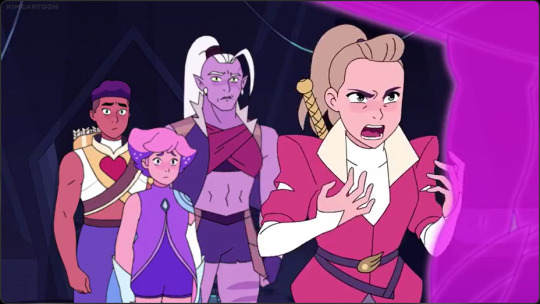
I want to point out that the monologue is the series’ thesis statement. The cyclical thing, the agency, the trauma. This is everything rolled into one.
The loop thing is a metaphor for the whole series, a metaphor made clearer by She-Ra itself.
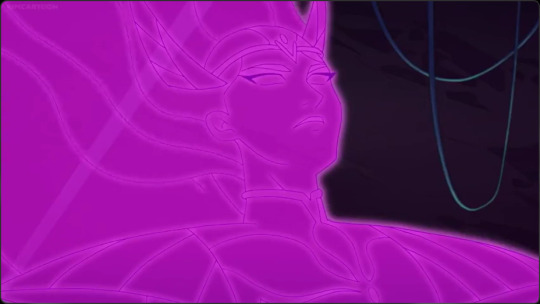
When Mara is introduced, she is transformed, and she is a failure. She is the warning that Light Hope gives to Adora. When we meet her in this episode, we get that same image.
“I am Mara, She-Ra of Etheria, and I am gone.”
It towers over Adora, looking down on her. Adora is beneath the vision of even a failure like Mara. At least, until she lets go of the sword.
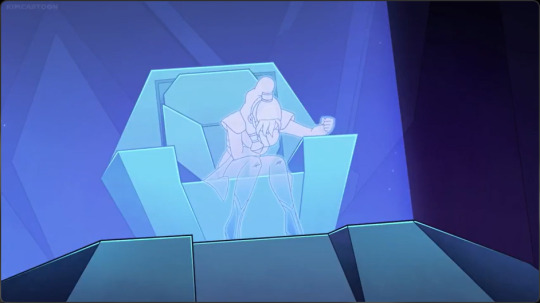
This is Mara. She’s small, about as tall as Adora; she’s wounded and dying; and she’s sorry.
“I couldn't stop them before, but I can now. Hiding is our only option. Maybe it's been a week. Maybe it's been thousands of years. I never wanted to be a hero. I won't be remembered as one.”
Mara’s character thematic can be summed up by one word: Legacy. Not how she will be remembered, but what effect she will have on the future.
Again, she is wounded, but she has managed to lock away an entire planet. Mara saved Etheria, once upon a time. I’d put that as pretty heroic.
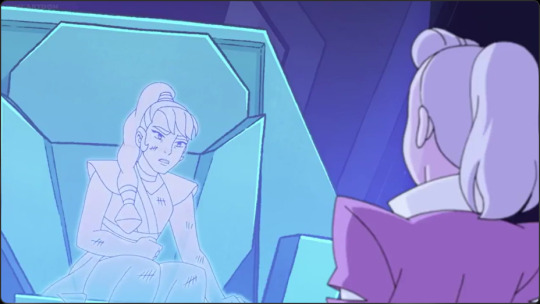
But this also spins the perception of Light Hope. Adora can now see the alternate side of Light Hope’s words, and she can see the lies and the mistruths. So, by leaving a message, Mara pushed Adora away from destroying the world. She created a failsafe for Etheria, by telling the next She-Ra to think and take their own agency.
Mara was living in a tragedy, her fate was to die, but she twisted it. She broke free, and she saved people. I wonder if that idea will be revisited.
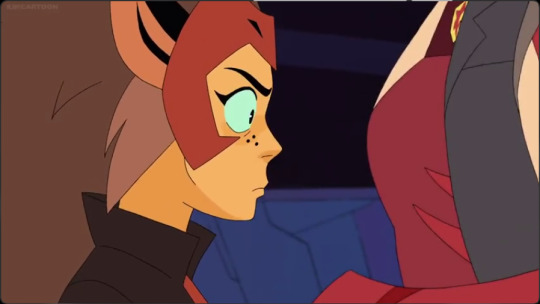
Final Thoughts
This episode could have been a season.
The second and third seasons of She-Ra are short, and I think the series would have been more interesting if they had been linked. Drop a few of the episodes, relocate some others, and make the whole thing about the Crimson Wastes. You get more time to Catra’s rise, and the fall feels more impactful.
I am mostly joking here. The series we got is the series we got, and this blog doesn’t analyse what could have been.
To that end, this episode falls short for me, because there isn’t enough of it. Catra’s improvement lasts for half an episode, and I think that if it had had a little more time to breathe, the gut punch at the end would have hit so much harder.
That is my critique, it’s a good episode, but it’s paced a bit too fast for me. You are welcome do disagree in the replies.
Next week, I will be looking at the absolute highway to hell (in a good way) that is Moment Of Truth, so stick around if that interests you.
Previous - Next
#rants#literary analysis#literature analysis#what's so special about...?#character analysis#spop#she ra and the princesses of power#she ra#spop adora#spop catra#spop scorpia#scorpia#she ra scorpia#she ra catra#catra#adora#she ra adora#the sound design on this episode is so good#the stings to imply the western vibe#the horde theme coming back when Adora reveals the thing about Shadow Weaver#this episode just needed a little more time and it would have been perfect
16 notes
·
View notes
Text
the MCU's rhetoric about political resistance/change is often so insidious. the only time we see people who want to change the status quo, theyre destructive and often incapable of feeling compassion for anyone outside of the group theyre fighting for. so the only two options are siding with the cruel antagonist who wants real change and the heroes who will make small concessions so that the audience feels good but ultimately they uphold the harmful status quo. I'm not saying this doesn't happen in real life, but when a trope pretty much becomes the default, you start to see the writer's political messages coming out. ESPECIALLY when the primary threat comes from exploited working class people/oppressed minorities and not the colonialist powers and corporations that put them in that position.
sidenote: when i watched black panther 2 and realized that the primary conflict was going to be black people fighting indigenous people and that western hegemony and exploitation of resources was just a side plot, I immediately lost all hope for that film. I loved the music, the visuals and the fight scenes, but the writing?? i was so disappointed. All the dissatisfaction I felt from Black Panther 1 came flooding back. Before they were pitting us against each other, this time it was against another oppressed group...hhhhhhh. anyway jokes on me for expecting different. I really just need to read The Deep (and if its anything like the song its based on, its probably much better executed than wakanda forever).
anyway, yes, the audience has the freedom to see things with nuance but i dont think most people will (because "its just a fun superhero move, why are you taking it so seriously?"), and I dont think the writers want them to - otherwise they'd start including more nuanced characters rather than villains who we are shown have to be defeated for the greater good, no matter how valid their arguments may be. and I understand that the vast majority of people are not watching superhero movies looking for nuance and depth but thats all the more reason why so much of the MCU's writing is concerning. Every time we're faced with a troubling political/ecological debate, the conclusion is that whoever tried to change things was in the wrong, and we'll make a small concession at the end so everyone feels somewhat satisfied and doesn't really have to confront any uncomfortable implications.
ex: infinity war shows us Thanos' eco fascism as the main (and only?) criticism of the overconsumption of resources. I may be wrong but I don't remember anyone talking about sustainability as vital solution or anything...and in FATWS the conversation is STILL about the pros and cons of the Snap - not anything to do with sustainability...because that would require the audience to be confronted with real life political implications that are bit too close to home. Even to have one or a few characters suggest an alternative and for Thanos to shoot it down because he doesn't trust people to be sustainable, and because he truly thinks killing people is the best possible plan (which makes no sense btw because it implies that all species are overpopulated at the same and that every single species in the universe consumes resources in the same way..they made movie!Thanos *seem* so intelligent but his thought process literally makes no sense. and fans bend over backwards to justify it because "hes the mad titan" even though you clearly cant use that defense based on the way he's written in the film. The writers clearly want us to see him as rational but cruel...anyway its not 2018 so let me stop beating the dead horse of this tired topic)
basically, theres rarely (if ever) a middle between the two extremes, because theres no room for that. There has to be a good guy and a bad guy...perhaps a well intentioned and misguided bad guy, but ultimately still a bad guy. The options are: pretty much nothing but minor things change and the problem still exists OR everything changes but it would require the violent villain getting their way and killing innocent people in the process.
anyway thank god for the spiderverse , which actually does the opposite (and thank god spiderverse is not directly part of the MCU and the writers actually have something to say). I think the loki show may be doing something similar but im not caught up so idk. loki to me feels like spiderverse but with less narrative cohesion
#mcu criticism#marvel criticism#say what you will about the boys but at least it has a message thats not half as wishy washy as the mcu
10 notes
·
View notes
Text
'I’ve been going about my life comfortably believing that Spider-Man: Across the Spiderverse would be the best western movie of the decade. And then came Oppenheimer.
After sitting on it for a while, I’m honestly still debating which was the best watch of the year so far, but regardless, managing to be on the same level as a Spider-verse movie (especially with an animation fan like me) is a feat of its own. Going into this movie completely and utterly blind, I absolutely loved it. I genuinely, wholeheartedly believe that it’s cemented itself as one of my favourite movies of all time. I know that’s a big claim, but trust me, Oppenheimer is worth it.
Since its premiere, most of the internet is already aware that Christopher Nolan’s latest film is a (mostly accurate) biographical retelling of the life of J Robert Oppenheimer, “the father of the atomic bomb.” Or, after watching the movie, I suppose American Prometheus is a better title.
At heart, that is how Nolan, adapting from Kai Bird and Martin J Sherwin’s book American Prometheus, portrays Oppenheimer; a man who gave humans the ‘gift’ of destruction and was tortured for eternity because of it. Instead of being chained to a rock and having his liver eaten daily like his greek counterpart, Dr Oppenheimer’s torture is a lot more internal and self-inflicted, if you will. And I imagine a thousand times more painful.
There are numerous themes within the story, as every good movie should have, but its soul is Oppenheimer’s own turmoil after creating the atomic bomb. Portrayed beautifully through Nolan’s writing and directing and acted out incredibly by Cillian Murphy, this was some of the best writing cinema has seen since, well, I would say years, but Spider-verse came out in June.
It was one of the best internal struggles I’ve seen in a long time. Keep in mind that although Oppenheimer’s turmoil mainly all leads back to guilt, it is also layered with the struggle we see between guilt, the damage he’s done by constructing a bomb that could destroy humanity, and the pride he has in serving his country and saving all the lives he did by ending the war early. Although short-lived, the struggle is there and it’s important. Even when barely feeling pride, his guilt increases and sends him down a spiral, trapped in his own mind. And with a mind as great as J Robert Oppenheimer’s, that’s a dangerous place to be.
This internal conflict was portrayed sincerely, authentically and subtly, with nuance and many different sides. Whether seeing him deal with it through denial, self-loathing, regret, desensitisation, morality or by openly disagreeing with the furthering of the arms race (cough Hydrogen Bomb cough) and also struggling with his feelings of pride, it was all done and written beautifully. I cannot say anymore without spoilers, but I’m sure you don’t need evidence; it’s Christopher Nolan, what would you expect?
However, if Oppenheimer’s turmoil was the soul of the story, then the frankly underrated and unmentioned theme of curiosity is the heart. Portraying the construction of the atomic bomb from the perspectives of the scientists that built it was a genius move, one that’s never been done before.
They just wanted to know. Which scientist would pass up the opportunity of doing the impossible? Of proving that they were the ones able to break all previously established rules? For a significant portion of the movie, that’s what the construction of the bomb was viewed with — curiosity, wonder and a challenge. These genius minds were simply and sincerely curious. And curiosity killed the cat. The sudden drop from that whimsy is one of the most effective thematic and tonal portrayals I’ve ever witnessed, both on and off screen.
It is widely known that the atomic bomb testing was successful, so it wouldn’t be a spoiler to mention that during its portrayal on screen, a few guys in the cinema started clapping. Gradually, a large chunk of the audience joined them, caught up in the moment. And, just a few scenes later, that exact thing is picked apart on screen in a tremendously directed and written scene — what exactly are we clapping for? The intentions were good, sure — they were celebrating the achievement of the impossible, in awe just like the scientists were. But it’s still the atomic bomb, the destroyer of worlds. This exact feeling was portrayed by Oppenheimer on screen and the way Nolan masterfully crafted it to fit with the audience and for the audience to relate to him on such a level, even if only for a scene, whether intentional or not, is the work of a master craftsman. To get the audience to feel shame.
Just like Oppenheimer.
Apart from him, the character of his wife, Emily Blunt’s Kitty, is also extremely well done, especially in the latter half of the film. She is the brawn to his brains, the fighter to his martyr, the (surprisingly) sturdy, albeit chaotic, anchor while he’s getting lost in a sea of his turmoil, and, simply, his wife. Yet, despite being a counterpart to ‘his’ everything, she is so distinctly and clearly her own. An incredibly written character, and although I can’t say I was very fond of her in the beginning, by the end of the film I almost had more respect for her than I did for her husband. Now, they sit equally high in my heart, as they do in the movie.
Other acting highlights were Matt Damon’s General Groves, Florence Pugh’s Jean Tatlock and Robert Downey Jr’s Lewis Strauss, as well as Tom Conti’s Einstein — his portrayal was surprisingly endearing. The themes of loyalty and betrayal are also worth mentioning, and how, contrary to the recent American imperialism trend present in most Hollywood movies, it’s actually both portrayed and, in my opinion, mocked. However, the most glaring point we haven’t discussed yet is Nolan’s masterful directing.
As a writer, I’ve discussed his genius enough, but as a director, no analysis or praise would ever be enough, so I won’t even try. Embracing his fragmented storyline techniques once again, the timeline is scattered, creating a wonderful sense of suspense, mystery and that there’s always more to the story. While some scenes are portrayed in a hard, black and white ‘factual’ lens, Oppenheimer’s own extraordinary life being played out in colour was not just symbolic but also helpful in differentiating between the narrative back-and-forth. The unexpected jumps and jolts of stars, space and atoms depending on what Oppenheimer’s mind was crafting or dissecting, added to both the chaotic and calm scenes. Either way, writer or director, Nolan is a true master of storytelling. Composer Ludwig Göransson’s masterful touch added to the scenes just that much more.
In conclusion, and honesty, I prefer to sit on a story for quite a while before grabbing my notebook and picking it apart, but with Oppenheimer, I could neither analyse without spoiling it nor wait to discuss it, so this review is a compromise. My only concern is that I won’t be able to do this gem of a movie justice so please, if you take anything away from this, let it be to watch Oppenheimer yourself. It’s the kind of movie I believe everyone needs to see.'
#Christopher Nolan#Oppenheimer#Ludwig Goransson#American Prometheus#Kai Bird#Martin J. Sherwin#Cillian Murphy#Tom Conti#Einstein#Florence Pugh#Jean Tatlock#Robert Downey Jr.#Lewis Strauss#Matt Damon#Leslie Groves#Emily Blunt#Kitty
2 notes
·
View notes
Text
geeking out about 3D anime
okay I *need* to talk to you about the anime movie BLAME! (2017). I didn’t expect it, but I immensly enjoyed the movie.
But let’s start at the beginning. I’ve read the manga back in the aughts, and even next to other popular cyberpunk/dystopian/dark manga, BLAME was so *different*.
Barely any words written on the pages, filled with immensly detailed drawings of megastructures that trap the sparse people inside; no horizon is visible, just structures over structures all around, piling up so high, neither ground nor sky are visible. Killy is a lone wanderer, ascending the structure-- A human being as detached from nature as can be.

later I learned how this unique look came to be; manga artist Tsutomu Nihei, and creator of BLAME, had been a student of architecture before he became a manga artist.
Accordingly, many of the panels were architectural in nature; they were “ma”, as panels without words are called, or “aida” which means “inbetween”. It’s a style of panel that isn’t common in western comic traditions, but is widely used in the Japanese way of storytelling: scenes that set the ‘vibe’, so to speak, let an emotion linger.
Not all panels shine like the ones above; you could tell the young mangaka was struggling with action scenes, which are plentiful, and especially faces. Both showed the effort with which they were brought into existence.

The action scenes sometimes are stiff, the faces skewed. They didn’t come easy to Tsutomu Nihei, although he immensly improved on that within the span of the 10 volumes BLAME ran. With time, however, I became fond of this peculiarity.
The world of BLAME is cruel and lonely; rarely does the lone wanderer Killy meet other humans, and even then, the connection is usually only very brief, be it because they die, Killy leaves, or the human turns out to be a machine in disguise who is out to kill every human it encounters. Maybe I’m sugarcoating things that needn’t be, but it made total sense for me that depicting those sparse humans would demand visible effort from the artist.
You can maybe now imagine my.... surprise when I saw the character design of the movie in 2017

anime eyes! so round and smooth! To me, it betrayed the rough and rugged style of the manga, I felt like I could re-watch K-On instead if that’s the style they were trying to sell me. Also, the Berserk movies had already ruined 3D animes for me, and I didn’t want to watch anything that didn’t have hand drawn anime characters anymore. Oh how foolish of me. We get back to that.
So, what changed my mind about watching BLAME? Glad that you asked cuz I cannot and will not stop talking about BATMAN NINJA. Seriously tho, do yourself the favor and watch Batman Ninja if you want to see a movie that is exactly as unhinged as it claims to be, and poses the perfect marriage between traditional Japanese art styles and modern 3D animation. Batman, several Robins, and a whole lot villains get teleported to feudal Japan, what more can I say. Prepare for some stunning views and increasing madnESS THAT WILL NEVER STOP AAAHH. Honestly, it’s a blast. I rewatch it yearly.

pease notice the traditional wave pattern (seigaiha) in the sky, which you usually find on Japanese fabrics, as well as the dry ink stroke look in the shadows of the characters. Here is another look:

first, a seigaiha pattern in the sky; then, Batman in closeup to showcase the rough ink brush strokes for shadows; lastly, Batman in his full armor cuz it’s dope.
ANYWAY. Watch Batman Ninja, let’s get back to BLAME. So, my faith in 3D anime was restored. It still took me a while to watch the BLAME movie, but I can only recommend it. I will probably make a couple more posts to properly geek out about it, but it’s on Netflix, it has some gorgeous shots that made me want to pause the film and gawk at them, and despite the low frame rate at times, when it goes all in, it goes all in and has hands down some stunning animation.
I absolutely LOVE that they decided to make the backgrounds entirely hand painted. Most of the time the background has no 3D whatsoever, or if there’s some, it is so subtly hidden that I didn’t notice it.


The 3D characters mostly blend well into the painted backgrounds, and I love the scratches on helmet and gear that are reminiscent of the rough ink drawings of the manga. Looking back, I cannot understand why I looked at the character designs and was disappointed. Scroll up and look at the face of the girl, she is a 3D model, no 2D. There are some gorgeous shots where you can’t tell that they’re 3D models at all, but I will keep those for a post where I’ll post spoilers. Can’t wait to get to that!
#blame!#blame! netflix#batman ninja#i know it's solely me who is populating the batman ninja tag; but i will if i have to#manga#anime#long post
18 notes
·
View notes
Text
Rating Versions of Harry Osborn: Updated
Wanted to redo this post with a more comprehensive and inclusive list of Harrys
616 Comics:

Just such a good and complex character. The OG Harry. His relationship with Peter just adds so much depth to every Green Goblin arc because of the inherent conflict of Peter knowing he needs to take down Norman Osborn, but not wanting to hurt or lose his best friend. (If you’ve read Kindred no you haven’t.) He’s still... ugly... I’m sorry 616 Harry... I love you so much but they did you dirty... Some artists do their best with what they have but... I’m not a big fan of western comic style in general so that doesn’t help. Has three failed marriages by the time he’s 30 because he’s gay and deeply closeted.
8/10
Spider-Man the Animated Series (1994):

The Harry plotline in this show reeeeally doesn’t feel earned, because the first time we see Harry having an active role in the show, he asks Peter to move in with him because Norman wants him to have a responsible studious roommate (a detail from the comics I was EXTREMELY excited to see play out), and Peter comments that they barely know each other. Ultimately they live together for all of one day before Peter decides to move back in with Aunt May. The next time we see Harry, MJ calls him Peter’s best friend, despite the fact that we haven’t seen Peter hanging out with—or even MENTIONING—Harry since the last episode when they were basically strangers. Really it feels like he’s just there to cause romantic drama as the guy MJ graciously settles for when she gives up on Peter. I found the whole goblin plotline kind of boring and lacking in depth.
3/10
Raimi Trilogy:

I was never interested in Raimi Harry until after I started liking and exploring other versions of Harry, because I just thought he was kinda a shit friend. He’s a pretty strong character overall, but his motivations aren’t as obvious. He’s torn between his love of Peter as his best friend, and his bitterness towards Peter for being the man his father wished he was. I don’t think Raimi Harry really wanted MJ, he just wanted to get back at Peter in a way by taking someone that HE loved.
However I feel like his characterization kind of sways back and forth between sympathetic and not depending on how he’s written in the scene, and it disappoints me that the thing that gets him to stop tormenting Peter is the butler telling him out of nowhere that Norman died from his own blade, rather than any real character development on his part.
6/10
Spectacular Spider-Man:
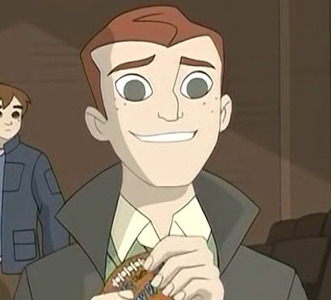
I still haven’t watched all of this show because I... can’t STAND this version of Peter... but I’ve watched many clips with this boy and he’s just... so sweet... He only wants to be loved and keeps getting his heart broken. Deserves better. On everything. He deserves a better father, a better best friend, better love interests, everything. I do really enjoy the way they incorporated 616 Harry’s drug abuse into this show with the Globulin Green, it was a very clever way to incorporate that aspect of his character, but tone it down for younger viewers. I’ve watched the scene of him getting “unmasked” as the Green Goblin about a million times it’s very good.
8/10
Ultimate Spider-Man:

I love him. Most people fear drifting apart from those close to us, so watching Harry struggle with the new and increasing distance between him and Peter as Peter seemingly makes new, “better” friends is downright heartbreaking. Especially when he overhears Sam implying that Peter only hangs out with him for his money which is something he’s clearly experienced a lot. (Seriously Sam what the fuck.) I also love his struggle with Venom throughout the series as a metaphor for his anger and bitterness, it’s never truly gone even when they work hard to remove it. It’s always there to bubble back up under extreme amounts of stress, especially when Norman is involved. (Also this isn’t a Norman review, but USM Norman is the only version of Norman Osborn that has rights and he works hard to be the father Harry deserves.)
Had an honest to God meet-cute with Peter like come on????
Its unfortunate how much they cut back Harry’s role in the third and fourth season, I really would have loved to see more of him.
Threw a party specifically so he could ignore Peter to his face because he was jealous and I respect that level of pettiness.
9/10
Spider-Man: The New Animated Series

I didn’t think it was possible to create an uglier Harry than 90s Harry but this blonde, fuck-boy lookin creepass came and proved me wrong. Who the FUCK is this?? Doesn’t have any recognizable characteristics of Harry Osborn besides being rich and hating Spider-Man. Also just... look at him. I wouldn’t trust this man anywhere NEAR my drink at a party. #NotMySon
-3/10
The Amazing Spider-Man:

He’s okay. I think he has some very emotional scenes and good chemistry with Peter, but it’s dampened by the fact that he wasn’t present in the first film and had to share the second with like two other main plot lines. Ultimately ends up being the least sympathetic version of Harry Osborn because he became the original Green Goblin and killed Gwen, rather than following in his father’s footsteps. That’s not to say he’s a completely unsympathetic character. He has a strong motivator in his fear of death, and I do think the choice they made for his character were interesting and could have developed really well, but they didn’t get the chance since the franchise was dropped.
5/10
PS4 Spider-Man:

ABSOLUTELY ADORE HIM. WISH WE GOT MORE OF HIM. HAVING YOUR EXPECTATIONS OF HARRY OSBORN BROKEN AS YOU SNEAK AROUND NORMAN’S PENTHOUSE AND LEARN THAT HE’S BEEN SECRETLY STRUGGLING WITH A GENETIC DISEASE HE’S BEEN HIDING FROM HIS BEST FRIENDS FOR YEARS WAS -chef’s kiss- GENIUS. PLEASE GIVE US A SECOND GAME WITH VENOM HARRY.
10/10
Marvel’s Spider-Man (2017):

Still easily my favorite version of Harry Osborn. When I first began watching the show I was startled by their decision to make Harry a science genius like Peter because it was so different from their usual dynamic, and many people who aren’t fans of the show point to this as something they dislike. But I actually ended up really loving the decision. It gives a different flavor to Harry in how he reacts to the events of the show and how we interpret his character traits, while still being very inherently Harry Osborn. Harry is jealous of Peter, he loves him dearly, but there’s always this ember of bitter envy ready to burst into anger whenever the plot creates friction between them. This is one of the defining traits of their relationship and in most versions it’s not hard to understand why. Peter has what Harry wants. He’s intelligent, he has potential, and most importantly he’s loved. Peter is the son Harry knows Norman wishes he had, and that creates a wedge between them. Marvel’s Spider-Man changes this dynamic. Harry can easily stand toe-to-toe with Peter in terms of intelligence, and in fact they often work together to create things or solutions Peter couldn’t have come up with on his own. That initial wedge between them isn’t there, creating a very endearing and loving friendship that we know is doomed to sour because it isn’t enough. MSM Harry could be the person Norman wants him to be, and that places the full weight of his father’s impossibly high expectations on his shoulders, always within reach but never quite achievable. So it makes a lot more sense why Peter initially has a low guard towards Norman (as opposed to some other series where Peter seems oddly dismissive of Harry’s justified complaints) and Harry’s own steadfast loyalty to his father. On the surface Norman seems like a perfectly loving parent, he encourages his son, he created an entire school for him when he was wrongfully accused of sabotage, it’s only when you start to dig deeper into their relationship that you see the subtle manipulations and the issues Harry has from constantly chasing his father’s approval. This creates a Harry who is desperate for validation and extremely sensitive to rejection, which colors his relationship with Peter throughout the show. I’m still mad he got nerfed in the second and third seasons because Disney is homophobic.
TLDR: I may be biased
... Infinity/10
MCU:

Where is he? Who knows? Man missing in action.
?????/10
#Harry Osborn#spider-man#msm 2017#did i rant about various Harry Osborns way longer than I intended to? Yes yes I did#if anyone reads this tell me if i missed any prominent Harrys lmao#long post
115 notes
·
View notes
Note
being honest i dont get jm using a award to say he misses tannie... we don’t know 90% of their lives but they are very close to the point of still sleeping together sometimes. and going deep if they were really a couple jm woudnt miss taes dog right? and even as friends he could visit it. unless its because of their schedule right... this kind of comment sometimes confuses me and haters will use it as “they arent close” lol. i just wanted to know your pov.
Judging by Admin 2's reaction, as well as some others in our asks, I have a feeling I was the only one with a more realistic expectation, or lack of expectations, as I waited for the BTS profiles to be posted. Based on last year's, I knew expecting something grand out of Tae, and especially Jimin, would just be me setting myself up for failure, which is what I think happened here.
But, let's discuss it.
I spent a solid couple of hours making an excel table last night that contains everything every member said about every member (sourcing 3 translators for maximum insight) to see if really what Jimin chose for Tae is so "bad" that suddenly people are sending us asks like this one, and another one I'll add later down the line. And the conclusion I've come to is that...what he gave to Tae, as well as Hobi and Seokjin, as awards are the only ones that have any actual emotional/personal connection to them.

With Namjoon and JK Jimin basically states the obvious--Namjoon is tall and JK has gained muscle mass, meaning nothing new or with a proper emotional connection was stated; to Yoongi he made the same request many other members have made, so a work connection, nothing inherently personal.
Now, compared to that--Seokjin teases him/them, which isn't new info, so Jimin asked him to stop or do it less, a valid request which I'm sure he also voiced to Seokjin outside of this FESTA profile and also shows a degree of personal connection; Hobi gets requested to not walk away after asking Jimin a question, which again shows a personal connection and that it's a reoccurring thing; and lastly Tae with Tannie.
Something I've noticed is that some ARMY, who are used to our western celebrities and draw conclusions about idols based on those parameters, forget that BTS are busy, like whatever you consider busy, take that and multiply it by ten. During his vlive with Hobi and Yoongi back in April, Tae said that they are much busier and their lives far more hectic than any of us realize. Taking that into account, and the fact that one of the members (I think it might have been Seokjin) mentioned they work at least ten hours a day for 360 days a year with practice, MV and CF filming, photoshoots, interviews, recording and working on music, meetings, and many other things we have no idea about, do you really think Yeontan lives with Tae full time? A dog needs to get walked and fed but if Tae is out of the house every day for at least ten hours, what would happen to Tannie? He'd just sit around at home alone all day which just isn't fair, so I'm sure Tannie lives with Tae's parents much the same way Micky lives with Hobi's parents and/or his sister, JKs dog lives with his family, Holly lives with Yoongi’s brother, Moni with Namjoon's, and years ago Seokjin had to give his sugar gliders to his parents because he was too busy to take care of them.
Based on that of that, I'm not sure how often Tae get's to see Tannie. Probably not all that often, to be honest. So, if Tannie's owner doesn't get to see him often, I'd assume Jimin gets to see him even less (if we work on the assumption that Tannie lives with Tae's parents and thus Tae could only really see him when visiting them or when they visit him, that means Jimin wouldn't be able to see Tannie just like that either, since that would be like intruding on family time, right?). And we know Jimin loves Tannie, so him using that award to say he misses him and is asking about him shows care and an emotional connection to Tannie. Do I think Jimin also asks Tae privately about Tannie? Absolutely. And still, while Jimin didn't give Tae the, I don't know, "hot body Award" like Yoongi did with Namjoon or the "person I love most in the world award" (which we should know by now would never happen, and if you expected something of that intensity level, than I'm sorry but you've set yourself up for disappointment from the start), he still drew a personal and emotional connection between himself and Tae, as well as the pet Tae loves dearly.
More below the cut:
Jimin could’ve asked about the other pets of the members, but he didn’t, he only ever really talked about Tannie, and here he does it again, so doesn’t that show that he has a bond with him, a closer one than the other members since they don’t/didn’t ask about him (except for Hobi that one time on weverse)?
Speaking of Hobi, am I the only one who finds it interesting and cute that he only drew little hearts for Jimin and Tae when writing down their awards?
Also, we have to remember that these profiles are for us, fan content (remember when Jimin asked Tae last year to post more pictures of Tannie on weverse because ARMY miss seeing him, so what if this is drawing a connection/parallel to that?), and not meant as the members “confessing” something to each other that they otherwise wouldn’t or don’t have the chance to do so. It’s not meant to be all that serious and instead just be fun and nice for us to read, show us a bit of their dynamic and that’s it, no world shattering revelations to be found, from any of them. Or do you really think Yoongi doesn’t like Jimin just because he told Jimin he’s trying too hard to be funny? It’s just part of their dynamic. Or that none of the members have anything else to say to JK besides commenting on his body/appearance? As for vmin, I’d like to remind us of this moment from their Friends subunit interview for FESTA 2020:

Whatever Jimin and Tae want to say to each other, they don’t need FESTA to do it, or us to be there as witnesses. Like Tae didn’t already say enough by telling us that 95z is love. Or Jimin by writing Friends.
From anon: because of you I came back da Namjin. I am a senior army and 2 years ago I left Namjin because I thought they broke up. You made me three Vmin but after what JK wrote about Jimin and after Jm himself about his chances I think that vmin are not together or Jimin withdrew. I think Jk would not dare to write about Jm that he has cute fingers etc if vmin were a relationship. it goes too far and confuses Jk too much. I don't want to say that J / k*ok is real because it certainly isn't !!!!
Now this is where I just sit and sigh heavily because it’s exactly what I expected and I will admit it irks me to no end. Let’s establish a little timeline:
Based on the FESTA Mission! BTS 4 Cuts Teaser that was posted earlier we can deduce that at least part of FESTA was already being prepared back in the first half of March, since on March 12th Jimin, Namjoon and Seokjin had their salad making vlive. Let’s suppose that everything FESTA related was prepared and written out by the members around that time as well. Sometime later BTS filmed YOU QUIZ followed by LET’S BTS and BTSxGame Caterers and everything else we’ve seen after that.


Or going a little further back to sometime in November 2020 while they were preparing for MMA 2020 and the Black Swan performance. We got the practice video today and if you pay attention to Jimin and Tae even there you notice that while Tae is waiting for his turn in the choreography, Jimin runs past him after his part is done (0:55) and they pat each other or do a “high five” or something along those lines as a way to cheer each other on. A very “we’re broken up” or “I will break up with him soon” thing to do, right? Or in min-January when Tae posted seven pictures out of which three were of just Jimin after an ARMY on weverse asked if anyone had any nice pictures they could use as wallpaper for their phone. Between all that I’m having a hard time honestly finding any moment where either of them seemed sad or “cold” toward the other the way you would be and feel if the person you love pulled away from you or broke up with you.

If you are still unconvinced and still think that is what Jimin tried to communicate to us, would Tae really have gone on national TV and said he likes Jimin the most? And would Jimin have agreed that he likes him a lot as well? Or looking at the making video of their Kloud Beer CF that was posted today as well, would Jimin really be looking and interacting with Tae this way if he decided to end things between them?

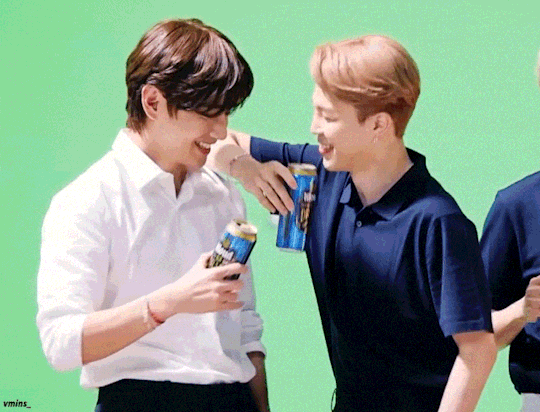

Also, going back a little, your mention of Jimin reflecting upon opportunities/chances now that it’s a new year. My question is based on what you made the judgment that this comment has to be about vmin and not about something entirely different in Jimin’s life, or maybe something connected to BTS as a whole? Just because of him asking Tae about Tannie? Jimin, as well as Tae and the other members, have entire lives outside of just their bonds with each other, entire careers, passion projects, families, friend groups, and that little bit of time they have to themselves, so immediately thinking Jimin’s comment must be related to his relationship/bond with Tae basically makes it seem like Jimin’s life is a romcom or a TV show in which the only thing that matters is if the main character will date or remain in a relationship with character B or not, but life isn’t like that.
Personally it reminded me of something Tae said during their Bring the Soul documentary about how BTS had the opportunities to go higher faster but they decided against them. Perhaps Jimin’s comment was about something like this as well, especially since we know Jimin is a very private person and very selective of the personal things he shares with us and the ones he doesn’t.
For the FESTA profile JK decided to give Jimin the “Cute Award” with the explanation that his “Face, height, fingers are cute” which, honestly, is just saying something that a) is true and b) has been said in millions of ways by every member across the last couple of years. I don’t see what the issue here is? During one of the episodes of BTSxGame Caterers Seokjin said that Jimin is very cute and that he has a small, beautiful face, so really he even added the word beautiful in there, which JK did not, so what really is the issue here? The fact its JK, right, that’s where the issue lies, to which I ask why? On this blog we’ve already established that there is (in our opinion and based on everything we’ve seen and heard) no romantic connection between JK and Jimin (nor Tae), not now and not in the past either, so why is him saying that Jimin is cute (which he is known for even by people outside of ARMY, or like James Cordon calling him his cute baby mochi) is an issue but Seokjin or any other member is not? Either we use the same measurements for everyone or we don’t compare or make such assumptions about any of them.
What I find curious, because this does make it seem like you, anon, are someone influenced by J*k*ok shippers and their opinions, see an issue in JK saying that about Jimin, and how that’s “proof” that Jimin and Tae can’t possibly be together, and yet you took no issue to Namjoon basically saying he wants to give Tae an award because he is so handsome he is above every list or Yoongi comparing him to Michelangelo's David, both of these being much more superlative and grand complements/awards than JK saying Jimin’s face, height and fingers are cute.
It’s funny how things that Jimin and Tae have said about and to each other that make their bond very clear (I want to live with my lovely Taehyungie forever or here is my love for you while handing Tae a bunch of red heart balloons or 95z is love, a statement I’m sure he wouldn’t post if that sentiment weren’t mutual) are all questioned or ignored, but something as basically trivial as a comment about Jimin being cute is turned into a major issue. The mental gymnastics is fascinating.
Lastly, going back to the first anon and their mention of how haters will use Jimin’s Award for Tae as “proof” that they “aren’t close anymore”--why do we care? Like Namjoon said in the Mic Drop lyrics Haters gon’ hate. They will say a lot of things about a lot of things and even make things up if they feel like it to push their agenda, so really, regardless of what Jimin would’ve said, or not said, they would’ve found a way to twist it and make it fit their narrative. Besides, what haters think has no actual effect or bearing on what Tae and Jimin have with each other, and neither does what other shippers claim. Haters and other shippers don’t control the narrative, BTS do, and everything Jimin and Tae have shown us in 2021, as well as the last eight years, shows me that their bond has only ever grown stronger and closer and more beautiful and awe inspiring, even while haters claimed they stopped being friends years ago, so why should you or I care what they think?
Like Yoongi once said in one of his vlives about how haters can write all they want, he won’t read it while they will get sued.
67 notes
·
View notes
Note
Is the popular headcanon that Nicky was illiterate, stupid and barbaric fitting in the stereotypes about Southern Europeans / Mediterraneans ? I’m guessing it’s from the American part of the fandom that’s choosing to not respectfully write Nicky since he is white while being virulent towards anybody that doesn’t perfected and accurately write Joe because he is MENA.
Hello!
Mind you, I am neither a psychologist, a sociologist nor a historian, so of course be aware these are my own views on the whole drama.
But to answer your question, yes, I personally think so. It definitely comes from the American side, but I have seen Northern Europeans do that too, often just parroting the same type of discourse that Anglos whip out every other day.
There is an abysmal ignorance of Medieval history – even more so when it concerns countries that are not England: there is this common misconception that Europe in the Middle Ages was this cultural backwater full of semi-barbaric people that stems unfortunately not only from trying to (correctly) reframe colonialist approaches to the historiographies of non-European populations (that is, showing the Golden Age of Islamic culture, for instance, as opposed to what were indeed less culturally advanced neighbours), but also from distortions operated by European themselves from the Renaissance onwards, culminating in the 18th century Enlightenment philosophes categorising the Middle Ages as the Dark Ages.
Now this approach has been time and time again proven to be a made-up myth. I will not go into detail to disprove each and every single one misconception about the Medieval era because entire books have been written, but just to give you an example: there was no such a thing as a ius primae noctis/droit du seigneur; people were aware that the Earth was not flat (emperors, kings, saints, etc, they were depicted holding a globe in their hands); people were taking care of their hygiene, either through the Roman baths, or natural springs, or private tubs that the wealthier strata of the population (and especially the aristocracy) owned. The Church was not super happy about them not because it wanted people to remain dirty, but because often these baths were for both men and women, and it was not that in favour of them showing off their bodies to one another. Which, you know, we also don’t do now unless you go to nudist spas. It was only during the Black Death in the 14th century that baths were slowly abandoned because they became a place of contagion, and they went into disuse (or better, they changed purpose and became something like bordellos). And, lastly, there was certainly a big chunk of the population that was illiterate, but certainly it was not the clergy, which was THE erudite class of the time. It was in monasteries and abbeys that knowledge was passed and preserved (as well as lost unfortunately often, such as the case for the largest part of classical literature).
So what does this mean? According to canon, Nicolò was an ex priest who fought in the First Crusade. This arguably means that at the very least he was a cadet son of a minor noble family (or a wealthy merchant one) who was part of the clergy. As such, historically he could have been neither illiterate nor a dirty garbage cat in his daily life.
Let’s then talk geography. Southern Europe (and France) was far, far more advanced than the North at the time and Italy remained the cultural powerhouse of the continent until the mid-17th century. Al Andalus in the Iberian Peninsula, the Italian States, the Byzantine Empire (which called itself simply Roman Empire, whose population defined itself as Roman and cultural heirs of the Latin and Greek civilisations): these places have nothing to do with popular depictions of Medieval Europe that you mainly see from the Anglos. Like @lucyclairedelune rightfully pointed out: not everyone was England during the plague.
Also the Middle Ages lasted one thousand years. As a historical age, it’s way longer than anything we had after that. So of course habits varied, there was a clear collapse right after the fall of the Western Roman Empire, but then things develop, you know?
Anyway, back to the point in question. Everything I whipped up is not arcane knowledge: it’s simply having studied history at school and spending a few hours reading scientific articles on the internet which are not “random post written by random Anglo on Tumblr who can hardly find Genoa on a map”.
Nicolò stems from that culture. The most advanced area in Europe, possibly a high social class, certainly educated, from Genoa, THE maritime superpower of the age (with…Venice). It makes absolutely no sense that he would not be able to speak anything past Ligurian: certainly Latin (the ecclesiastical one), maybe the koine Greek spoken in Constantinople, or Sabir, or even the several Arabic languages from the Med basin stretching from al Andalus to the Levant. Because Genoa was a port, and people travel, bring languages with them, use languages to barter.
And now I am back to your question. Does this obstinacy in writing him as an illiterate beast (basically) feed into stereotypes of Mediterranean people (either from the northern or the southern shore)? It does.
It is a typically Anglo-Germanic perspective that of describing Southern (Catholic) Europeans are hot-headed, illiterate bumpinks mindlessly driven by blind anger, lusts and passions, as opposed to the rational, law-abiding smart Northern Protestants. You see it on media. I see it in my own personal life, as a Southern Italian living in Northern Europe for 10 years.
Does it sound familiar? Yes, it’s the same harmful stereotype of Yusuf as the Angry Brown Man. But done to Nicolò as the Angry Italian Man (not to mention the fact that, depending on the time of day and the daily agenda of the Anglo SJW Tumblrite, Italians can be considered either white or non-white).
Now, the times where Nicolò is shown as feral are basically when he is fighting (either in a bloody war or against Merrick’s men) or when Yusuf is in danger. Because, guess what, the man he loves is being hurt. What a fucking surprise.
Nicolò is simply being reduced to a one dimensional stereotype of the dirty dumb angry Italian, and people are simply doing this because they do not seem to accept the fact that both he and Yusuf are two wonderfully complex, flawed, fully-fledged multidimensional characters.
So I am mainly concentrating on Nicolò here because as an Italian I feel more entitled to speak about the way I see the Anglo fandom treating him and using stereotypes on him that have been consistently applied to us by the Protestant Northerners. I keep adding the religious aspect because, although I am an atheist who got debaptised from the Catholic Church, a big part of the historical treatment towards Southern has to do with religion and the contempt towards Catholic rituals and traditions (considered, once again, a sign of cultural backwardness by the enlightened North).
I do not want to impose my view of Yusuf because there are wonderful Tumblr users from MENA countries who have already written wonderful metas of the way Yusuf is being depicted by non-MENA people (in particular Americans), especially (again) @lucyclairedelune and @nizarnizarblr.
However, I just want to underline that, by only ever writing Yusuf as essentially a monodimensional character without a single flaw, this takes away Yusuf’s canon multidimensionality, the right he has to feel both positive but also negative feelings (he was hurt and angry at Booker’s betrayal, allegedly his best friend, AND HE HAD EVERY RIGHT TO BE – and I say this as a Booker fan as well).
I have not been the first to say these things, it is nothing revolutionary, and it exactly complements what the MENA tumblr users in the TOG fandom have also been trying to say. Both of us as own voices people who finally have the chance to have two characters that are fully formed and honest representations of our own cultures, without stereotypes or Anglogermanic distortions.
And the frustration mounting among all of us comes from the fact that the Anglos are, once again, not listening to us, even telling us we are wrong about our own cultures (see what has happened to Lucy and Nazir).
What is even more frustrating is that everything in this cursed fandom – unless it was in the film or comics – is just a bloody headcanon. But these people are imposing their HCs as if it were the Word of God, and attacking others – including own voices MENA and Italians – for daring to think otherwise.
I honestly don’t expect this post will make any difference because this is just a small reflection of what Americans do in real life on grander scale, which is thinking they are the centre of the world and ignoring that the rest of the world even exists regardless of their own opinions on it.
But still, sorry for the length, hope I answered your question.
#i am also expecting to receive lots of shit for this but can't say i care#the old guard#tog discourse#nicolo di genova#the old guard meta
238 notes
·
View notes
Text
Star Wars Novel Rankings
In celebration of the end of this year, I made a tier list of all of the Star Wars novels I’ve read since I joined this fandom in 2017 (which you can use to rank these books too). And I named all the tiers in a dorky but appropriate fashion. I would love to hear your thoughts on my rankings, as well as how you’d rank the books yourself! I’ve had a blast reading Star Wars novels from both Disney’s canon and the Legends extended universe over these past 3 years. Here’s to many more years of reading stories from the galaxy far far away!
I put longer (but not more coherent) thoughts below the cut.

The Chosen One: Bringing Balance to the Force and My Depressed Soul
1. The first spot of top tier had to go to Matthew Stover’s Revenge of the Sith novelization for obvious reasons. You simply cannot beat it. It’s a masterpiece. I literally had to put the book down to scream when I read the prose associated with the opening battle over Coruscant. It gave a whole new meaning to the triumphant music and the synchronous twirling of Obi-Wan and Anakin’s starfighters as they weave through blaster-fire in the battle over Coruscant. The rest of the book is the same way. You can’t put it down. I have wAyyYyYy too many feelings about this book oh my god.
2. Thrawn was a surprising book for me. For being centered on an admiral of the Empire’s navy, it had so much heart in it! I loved reading from Eli Vanto’s perspective too. god dammit I love that freaking Wild Space hillbilly dweeb with all my heart. I think his experiences getting to know Thrawn and learning from him guides the reader to feel much the same way as Eli by the end. Thrawn is a trusted friend, not the enemy you expect him to be. I could have done without Arihnda Pryce but she’s supposed to be unlikeable so I won’t blame Timothy Zahn this time.
3. The Clone Wars Gambit duology is basically Karen Miller writing fanfic and I’m HERE FOR IT. As is tradition with Karen Miller’s Star Wars novels, the emotions are dialed up the eleven. Our favorite dumbass Jedi team is back at it again with a mission to save the galaxy and this time they end up going undercover as two lumberjacks from the boonies. Anakin holds an energy shield back from collapsing with his bare hands like a total badass. Obi-Wan is in love with another woman despite it always ending in tragedy, while also bickering like a married couple with Anakin every ten seconds. get a fucking room, you two. These two books inspired one of my fics so they’re near and dear to my heart.
Jedi Master: These Books Have A Seat On The Council Too
4. Wild Space was appropriately named, I’ll tell you that. It’s a wild ride from start to finish. *slaps the front cover* this book can fit so much of Obi-Wan’s suffering in it! @forcearama has elaborated on the many reasons why this book is a gem in Snark Wars blog posts (linked here). It’s also the beginning of the best team-up since Anakin and Obi-Wan...Bail and Obi-Wan! These two bastards get under each other’s skin but it makes for the perfect character development. This book is the reason I screech with delight whenever Bail Organa appears on screen, or is mentioned in conversation. Bail gets a mysterious tip about trouble on a planet, and Obi-Wan decides to go with him to investigate. Cue Sith-induced suffering. It’s cool to see a normal person experiencing the weirdness of Force sensitives and how the world has this extra level of sensory information in it. Plotwise this one isn’t the best, but I think the interactions between characters really shine in this novel. Karen Miller’s writing is like a cup of hot chocolate to me. Indulgent character insight, full of sweet moments, has a bunch of extra marshmallowy dialogue, you’re reading it to have a good time but not to be satisfied with plot. You get me?
5. Do I even have to explain myself here? Kenobi by John Jackson Miller is both an interesting western-style tale set on Tatooine, and a beautiful character study of a man stricken with grief he keeps suppressed. How does one continue on when their whole family was murdered and their whole culture burnt to ash? I wanted to give Obi-Wan a hug the entire time I read this. The characterization was spot-on, from the way he wrangled animals to the way he severed a man’s arm off in a bar with his lightsaber. And when he meets a woman named Annileen Calwell, or Annie for short, Obi-Wan can’t bring himself to call her by her nickname ever and if that doesn’t just break your damn heart fucking fuck.
6. Ahsoka was the first Disney canon book I ever read and it kickstarted my love for E.K. Johnston. The writing is simplistic, but that makes it easy to jump into. Overall, it’s a quick and enjoyable read. By far the best parts are the flashbacks that mull over memories Ahsoka has of the time before Order 66. That shit hits you right in the heart, man. And the part where Ahsoka equates Obi-Wan and Anakin to her adoptive family ohhhhhhh god the tears they flow like a river. There are scenes that allude to Ahsoka becoming the vital part of the Rebellion we know her to be from Rebels, balanced with her current struggles to survive and find herself. Despite having cast away her identity as a Jedi and having any remaining bits of her culture destroyed by Palpatine, Ahsoka shows us all how bright a hero can shine in the darkest of times. AND SHE WAS WRITTEN AS QUEER! finally some good fucking food.
7. Oh shit, another E.K. Johnston book? Don’t be surprised. She’s a prequel fan and so am I, hence why Queen’s Shadow is so high on the list. E.K. Johnston pays homage to our favorite queen and badass senator Padme Amidala. There’s politics, there’s solidarity between female characters, and Bail Organa is in it so you KNOW I simply must give it a high rating. All jokes aside, I thought the story added lots of little details to the world of Star Wars without it being all stereotypical sci-fi nerdy language. You know how people want to describe something beyond our technological capabilities so they throw a bunch of nonsense together like “pre-praxis crystal bio-anode circuitry”? I’m looking at you, Karen Miller, I love you but please. There is none of that in this book. It makes sense, it adds color and culture and life to the worlds of Star Wars. Most of all, it devotes time and love to developing Padme outside of her place in canon as Anakin’s wife, Queen of Naboo, and Senator. She is all of these things, but she’s human too. I do agree that the pacing is slow, but it’s something meant to be savored, I think. E.K. Johnston really shines when she’s writing dialogue because she gets these characters. That’s something to appreciate, because not all canon books agree with the way we’ve perceived the characters as an audience.
8. Rogue Planet chewed me up, spit me out, and declared me an even bigger stan for The Team. People who say Qui-Gon would have been a better master for Anakin can ~get out~ because I could read about these two hooligans getting neck deep in space shenanigans all damn day. Anakin is like twelve, which is a time in his training that we don’t get a lot of in canon. Personally, I think it was equal parts heartwarming and funny to read about their adventures. There is some angst sprinkled in there because hey, we’re reading about Anakin here, let’s not forget the emotional trainwreck that is Anakin Skywalker. The duo is sent to a planet that makes super fast ships that are ?sentient? or at least biologically active. They bond with the pilot, which makes Anakin perfect for this mission. There’s a scene where these little floof things attach all over tiny Anakin because he’s so strong in the Force and it’s god damn adorable how dare he?? I’d probably rate this one even higher if I read it again, but it’s been awhile. Characterization is spot on and reminiscent of Matthew Stover’s writing in how it highlights the strong bond between Obi-Wan and Anakin, how they’re fated to know each other. I’m a sucker for soulmates, what can I say?
9. Lost Stars reads like a movie. Not a script, but just the perfect amount of detail that you can imagine the scenes but the pacing is still quick, the dialogue smooth and natural. I couldn’t help wishing this was a film because the story was so all-encompassing. The highs and lows of the emotions of both protagonists, their relationship developing, the differences in culture. Folks, this book has it all! It’s a totally different perspective on the events of the original trilogy, seen from the side of Imperial cadets training to become pilots. Eventually, one splits off and joins the Rebellion while the other perseveres in the Empire. It’s like star-crossed lovers, but covers so much more ground than that. And the characters are fully developed. These original characters knocked my socks off, and that’s hard to do since I’m usually an Obi-Wan stan through and through. For anyone uncertain of reading Star Wars novels, this book is a great place to start. Action-packed, emotion-filled, and stands on its own despite weaving perfectly into the established universe. What more could you want?
10. Back at it again with the prequel shit, amiright? Queen’s Peril is E.K. Johnston’s most recent Padme-centric novel and it does not disappoint fans that wanted a taste of the Queen’s side of the story. Set during the events of The Phantom Menace, we get a “behind the curtain” look at how all of the handmaidens came to be more than their title suggests. There’s teenage girls getting stuff done! It makes more sense why Padme was elected ruler of her home-world, and you come to appreciate that a royal leader is not alone; there’s actually a whole team at her side to help her overcome everything from the drudgery of daily governing to Trade Federation blockades that threaten to starve her people. I think if you enjoyed Queen’s Shadow, you’ll enjoy this book a lot. For those that are unfamiliar with Johnston’s work, I wouldn’t recommend this one first because it does cover events you’ve already seen in movies and therefore is a less suspenseful companion to them. On the other hand, because it does tie in with TPM, it doesn’t suffer from the pacing issues of Queen’s Shadow to the same degree. I read this all in one sitting, so it’s definitely fun, but wasn’t compelling enough in its character development to elevate the book past some of the others I’ve listed already.
11. Thrawn: Treason was a refreshing return to the Grand Admiral we all know and love after the second installment in this series slowed things down a bit. Although it wasn’t as character-driven as the first book (which I love with all of my heart), there were still many moments that had me cackling at the disparity between Thrawn’s immense intellect and the other Imperials’ sheer stupidity, and that’s what we’re here for in a book about the Empire, right? There’s a lot of pressure on Thrawn, as his TIE Defender project has been pitted against Director Krennic’s Project Stardust. Who will get the funds? We just don’t know?? Tarkin sits in between the two and as usual, manipulates everything to his advantage. Palpatine questions Thrawn’s allegiance to the Empire after some of the choices he has made, leaving him in even more of a pickle. Thrawn is sent on a wild goose chase task that should definitely end in failure (on purpose because Imperials all want to watch each other burn as much as they want to watch the Rebellion burn), but you know Thrawn will find a way. My main squeeze Eli Vanto makes his return after being absent from book 2. Missed you, my sweet sweet country boy. He doesn’t have a leading role in this novel, but every scene he’s in makes the story better. Thrawn says “perhaps” way too often for my taste, but if you can ignore that, this book is a solid read. Equal parts action and deductive reasoning, as any Thrawn book should be.
12. Most of Dark Disciple had me thinking this was going to be a top tier book, and damn do I wish we could have gotten this animated. We follow Quinlan Vos and Asajj Ventress on a mission to assassinate Count Dooku. Why the Jedi thought this was a good idea, I don’t know. But I’m here for it all the same. 3/4 of the adventure were intriguing, but the ending didn’t do it for me. I won’t spoil things for anyone who hasn’t read this yet, but after all of the character development, to have it squandered so quickly just left me disappointed? I got really attached to everyone in this novel, and I’m sure you will to. I’ve read this and listened to it as an audiobook, and actually I think it’s more memorable as an audiobook. Would recommend, except for Mace Windu’s voice being exceptionally southern for no reason. Weird. I think this novel captures all of the great things about The Clone Wars show; time to really get to know each character and their motivations, action and adventure with the darkness of impending doom tinting everything, and lightsaber fights! Plus, Obi-Wan and Anakin make appearances in this book and it just adds that extra bit of spice. Worth the read, even if you know they aren’t going to get Dooku in the end (which I am still mad about, screw that guy).
Jedi Knight: Passed the Trials but There’s Room for Improvement
13. Few books in the Star Wars universe are centered around characters with no use of the Force, but in Most Wanted, we see a young Han Solo and Qi’ra struggling to survive on Corellia and it provides a humorous but compelling backstory to both characters in the Disney canon. Han is his usual lucky goofball self, and Qi’ra is smart and cunning. You can see how they grew into the versions of themselves in Solo. While the book stays on the lighter side of things (typical of stories written for a younger audience), there are still moments of depth on droid rights, viewing the Force as a religion, and what life is like in a crime syndicate. Addressing these heavier topics without it killing the pace of the story is hard to do, but Rae Carson pulls it off flawlessly. I went into this book with no expectations and was pleasantly surprised by how much fun I had. Han and Qi’ra start off as competitors, but eventually have to learn to work together to survive as more and more people start hunting them down. They’re honestly so cute together, I loved their dynamic. It makes Solo a better movie, and although I liked it on its own, characters like Qi’ra needed a little more time to get to know, which you can get here!
14. Thrawn Alliances was not what I expected at all, and it took me a lot longer to get through. Hell, it has Thrawn, Anakin/Vader, and Padme in it! What’s not to love? Apparently, a lot. The different timepoints and perspectives in this were more jarring than anything else. Although the interactions between Thrawn and Anakin/Vader were enjoyable, it was not enough to elevate this book into the Jedi Master tier. Things felt dry, the characters didn’t grip me like in the first Thrawn, and it all felt like a ploy to introduce Batuu into canon before the launch of Galaxy’s Edge.
15. Leia: Princess of Alderaan was a dive into young Leia’s life before we see her in A New Hope even though this was marketed as a journey to The Last Jedi book, which I disagree with. We really haven’t seen any content about Leia in this time period before, and although I can’t say I was looking for this, I did enjoy it. The book was a little long, but there was adventure and the seeds are planted for Leia to be a bigger part of the Rebellion. The romance wasn’t too memorable, but Holdo wasn’t pointless in this (a stark contrast to her brief appearance in TLJ just to sacrifice herself). There’s a hint about Leia being Force-sensitive but it’s not in-your-face. It’s a typical coming-of-age story but in the gffa. The best part about this is seeing Bail and Breha as parents. I’m forever in pain that we didn’t get to see more of this in movies because it’s so so sweet. Leia must choose what kind of person she is going to be--and what kind of princess she will become. It won’t be for everyone, but I liked it.
16. Master and Apprentice was a typical Star Wars novel, which means it’s full of original characters that are strange and outlandish to serve the plot, a new world full of beautiful landscapes, and Obi-Wan suffering. I want to make it clear that this book is 80% Qui-Gon, 10% Rael Averross, and 10% Obi-Wan. I was expecting it to be 50% Qui-Gon, 50% Obi-Wan, as the cover suggested. Although I was disappointed by that, the story overall was okay. Qui-Gon is kind of an asshole in this? When is he not, though. We really get to sink our teeth into the way he and Obi-Wan fundamentally disagree with each other, so much so that their teacher-student relationship is falling apart. Tragic! They go on one last mission before calling it quits. Qui-Gon is in over his head with prophecies, Obi-Wan just wants to follow the rules, and Rael Averross is Dooku’s previous apprentice that is living his best life as a regent until Pijal’s princess comes of age. Don’t get me wrong, it’s a solid book. I just don’t vibe with Qui-Gon and want to whack him upside the head every time he avoids confrontation with his own student. My protectiveness for Obi-Wan is showing again, isn’t it? Yikes.
17. James Luceno is one of the most analytical authors I’ve ever read anything from, but it seems to always work? Tarkin is all about...well, Moff Tarkin. He’s ruthless, intelligent, and just downright evil. His backstory was compelling and I found myself drawn into the story by the details, although it is dense and took awhile to finish. I’m not interested in him as a character, but despite that, I enjoyed this story. The plot wasn’t memorable enough for me to recall after 3 years, but it’s similar to how Thrawn rose through the ranks of the Navy, just in a different part of the Empire’s governing body. We don’t get many books completely focused on a villain (I don’t count Vader ones because we know who he was before and the whole damn saga is about him), but this one is good! Don’t be fooled by it only being in the Knight tier. I think people who read a lot of sci-fi will like this book a lot. This is like the opposite of Queen’s Shadow, basically. If you had gripes about that book, you might like this one instead.
18. Battlefront II: Inferno Squad was a worthwhile read for anyone who played Battlefront II. Iden Versio is a great protagonist in the game, and I think Christie Golden totally gets her character. She’s nuanced and relatable. The whole team is interesting and getting introduced to each member before the events of the game makes everything mean more. That’s the real goal of any prequel story, I think. Accomplished! The action scenes are on point, the plot served to highlight what makes Inferno Squad special, and you get a sense for the morally grey area anyone must function in as an operative for the Empire. Although not necessary for the greater canon, it’s a great adventure. Iden and her squad members infiltrate the remains of Saw Gerrara’s group (they’ve become a bit of extremist) and destroy them from the inside. It’s got the suspense of a spy thriller and all of the nerdy space opera elements you expect from Star Wars. Although it’s weird to jump into a story not knowing any of the characters, you’ll get attached to Inferno Squad fast. Well, except for Gideon Hask maybe. He’s kind of a dick.
19. If you’re craving some Dark Side action, Lords of the Sith will give you what you’re looking for. Sidious and Vader crash-land on Ryloth and have to work together to survive, and also defeat the Free Ryloth Movement led by Cham Syndulla. It’s all fucking connected, guys. I love when people weave together stories that fit into the canon timeline like this, bringing in side characters and allowing them to develop some depth. And a chance to sink into the mind of a Sith Lord is always fun, if you’re in the mood to read about destruction and anger. It’s cathartic sometimes. If you’re always wondering, why didn’t Vader just stab Palps when he had the chance, this book explains their dynamic more. It didn’t really change my opinion of any of the characters, which is why it’s not higher on the list.
20. Catalyst suffered from being in a really boring part of galactic history. Despite that, Galen Erso and Orson Krennic have a hilarious relationship that I would have loved to see on-screen. This book really develops Krennic to become more than just the whiny entitled evil man we saw in Rogue One. He’s ten times worse now! But I mean that in the best way, I laugh whenever he’s in a scene, that sassy man just brings me joy. James Luceno is at it again, making things as detailed and dry as possible. I read so many of his stories right at the beginning of my journey through Star Wars canon and it’s a wonder I didn’t quit. Some of them are dark as fuck. And also slow as hell. With this one, I think it all comes down to what you want out of a Star Wars novel. Some people will really enjoy the plot. I think seeing how Galen became a part of Project Stardust was interesting and every time something about the Death Star became more clear, I screeched because I knew what it would eventually become. This book may not hold your interest though, which is why I put it lower on this list.
21. Star Wars: Clone Wars was a decent retelling of the Clone Wars movie. I liked it because I liked the movie, but you have to be able to sit back and enjoy the ride, not thinking too much about the silly parts. For that reason, it’s pretty far down in the rankings. Ahsoka is young and liable to get on your nerves. I certainly wasn’t her biggest fan at this point in the series. The biggest problem is that Karen Traviss is very anti-Jedi. Some authors for Star Wars tend to do this? To me, it’s weird. I didn’t notice it too much because it was one of the first Star Wars books I read, but it contrasts starkly with the truth of the prequel trilogy and some of the other entries in the Clone Wars Novel timeline, like Karen Miller’s books. Needless to say, although this book wasn’t super memorable aside from the familiar plot, it kept me reading Star Wars books, and so it is at least an average book. Plus, any content with Anakin and the clones is worth it for me. I love them.
22. A New Hope was good, for Alan Dean Foster. I’m not a fan, I’ll be honest. But this novelization stands on it’s own. I’m going to have to do a re-read to really go in depth on why this isn’t farther up on the tier list, but the movie is always going to be better to me. If you want to re-live the great beginning of the Original Trilogy, it’s worth your time. I mean, the story is full of adventure and mystery and lovable characters. What’s not to love? I just feel like the movie really elevates the narrative with a great score and fun character design/costumes/sets.
Padawan: These Books Have Much to Learn
23. Attack of the Clones was more entertaining than The Phantom Menace because the characters are in funnier situations. Obi-Wan and Anakin chasing Zam Wesell through the levels of Coruscant? Hilarious, just like the movie. Anakin and Padme falling in love as they spend time together? Holy fuck it’s so much better than the movie. Please read it for that alone. Outside of that, the writing style didn’t really impress me. And my experience with it wasn’t super memorable. There was potential to really make the inner dialogue of these characters impactful, to really develop the story of Obi-Wan, Anakin, and Padme beyond what we could get from the movie scenes alone. I didn’t think it went above and beyond there. Not a bad story at all, but you don’t get to look at Hayden Christensen, Natalie Portman, or Ewan McGregor the whole time either, so therefore I must rank it lower. So many beautiful people in that movie, holy shit. You can understand my, dilemma, yes?
24. I enjoyed parts of The Phantom Menace book, like deleted scenes with Anakin living on Tatooine before Qui-Gon and Padme meet him. The additional depth is lovely, but I think a story like Queen’s Peril adds more to TPM than this book does. The story overall is still fun. I love this movie so much, it’s hard for me to be critical. I did put a lot of post-it flags in my copy, so it does develop the characters and get you thinking beyond your expectations from the movie. What more could you ask for from a movie novelization? I’d say not much, if I hadn’t read Revenge of the Sith and had my fucking mind blown. In comparison to that, this one is just okay.
25. The Last Jedi novelization wasn’t bad, necessarily. It tried its best to bring this story up to par with some of the interesting novels that don’t have movie counterparts. But still, the plot suffers because of how this movie was made. It’s very focused on Rey and Kylo, and Finn’s little adventure with Rose seems pointless in the grand scheme of things. I’d rather read this again versus watching the film, but that’s all I’ll say on this because I’m trying to keep my opinions on this movie to myself to avoid digging up old arguments. Jason Fry did well, and of the two Sequel Trilogy books I’ve read, I would recommend this one over Ep. 7.
26. The Force Awakens falls short and I think it’s because of Alan Dean Foster’s writing style on this one? It didn’t really expand on anything from the movie, while taking away the beautiful music and visuals. This novel is the antithesis of Revenge of the Sith’s novelization, and for that reason I ranked it fairly low. I wouldn’t read this one unless you really really love the Sequel Trilogy.
27. To be fair, I read the new Thrawn book before I went back and read this one. Even so, Heir to the Empire didn’t impress me at all. Thrawn didn’t seem like a thrilling villain with lots of depth like he did in Timothy Zahn’s reimagined Thrawn novel. We barely saw him. A lot of time was spent on the Original Triology’s trio, which waasn’t bad. I thought Luke, Leia, and Han were all written fairly well. The latter part of the story was redeemed by the interactions between Mara Jade and Luke, for sure. Enemies to lovers, anyone?? Without Thrawn, this book would have been an entertaining story, but for all of the praise it has received from long-time Star Wars fans, I was expecting to be blown away and I wasn’t. Maybe I have to continue the triology to figure out what all of the fuss is about, but after this one, I’m not super motivated to read more. Change my mind?
28. Cloak of Deception really shines when you’re following Palpatine’s perspective because you can feel the undercurrents of his master plan to destroy the Republic underneath his calm persona as a Senator. Other than that, it’s a forgettable plot. This is all about galactic politics and some terrorist group trying to blow up some government officials. Basically the most boring parts of the prequel trilogy. I listened to the audiobook of this at the beginning of this year and I already forget what it’s about. Qui-Gon and Obi-Wan should have been able to bring some humor and energy to get you rooting for the good guys, but there was barely any of that. I was disappointed in all of the characters. Everything felt distant, removed from the heart of the characters. Some people in reviews have argued that the events of The Phantom Menace really pinned this novel in a corner because you already know what happens, but I disagree, because we know how Revenge of the Sith goes and The Clone Wars show is that much more tragic and heartbreakingly beautiful because of it. Prequels can be done right. This ain’t it, Luceno. Sorry.
29. Star Wars: The Old Republic, Fatal Alliance needs to go home and rethink it’s life. I’m a huge fan of the Old Republic and I’ve put like 200 hours of my life into playing that game, so I was hoping for some fun content in this part of the timeline. Sadly, this book captured the worst parts of the game, like the fact that there’s way too many factions at war with each other. Jedi, Sith, Empire, Republic, Mandalorians. They’re all here. They’re all ready to throw down. And I’m tired. As with many of the books in this lower tier, I felt there wasn’t enough description of the world or the people in the story. We’re in the gffa, be a little weird and wacky. Be big and bold! Make things terrifying, or beautiful, or both. But give my mind something to work with. The number of characters made the plot messier than it could have been, and it definitely isn’t worth the read. I can’t speak for all Old Republic books, but this one didn’t impress me.
A Sith Lord?! On My Bookshelf? It’s More Likely Than You’d Think
30. So underwhelming, you might as well just read the first half and then stop. Last Shot is absolutely terrible, except for Lando Calrissian’s characterization, which was spot-on. If the whole story had been from his perspective, I probably would have a much difference opinion on the novel as a whole. Sadly, this is not the case. Han was boring, he bottled up his emotions, and seemed drastically different from the badass he was in the original trilogy. There are different timepoints in this novel, and in all of them, Han is unrecognizable. Don’t nerf one of your main characters like that. Daniel Jose Older and I might just not get along. I thought his writing style didn’t fit Star Wars at all. It was like breaking the fourth wall, totally pulling me out of the story constantly. Also, there were little to no descriptions of body language, locations, or movement. It left me feeling disoriented the whole time I was reading. I thought one of the most interesting things would have been seeing Han, Leia, and baby Ben being a family at this point in time, but Han’s family was there as a prop, nothing more. There was a big bad item that was going to cause galactic destruction and our heroes had to go save the day. There was barely any tension and no one lost an arm so I’m pretty pissed off. Is it Star Wars if no one gets their appendage removed? I can’t tell you how much I disliked this book. Which is sad because I was hoping to enjoy it. I like Han. I like Lando. I like space adventures. I’m not that hard to please, or at least I don’t think so.
#Star Wars Novels#tier ranking#long post#i worked hard to put my thoughts into words for you guys#i read these books over a long period of time but I thought I'd encompass all of it in one post#sw lit#i've had so much fun becoming a part of this fandom#and I love the conversations about the books and the gffa in general#hopefully this will inspire some discussion!#i would love you guys to make tier rankings as well#they're always my favorite youtube videos to watch
132 notes
·
View notes
Photo
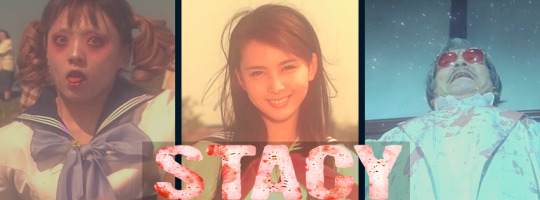




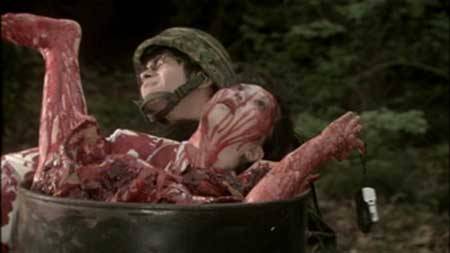


Published on grimoireofhorror.com and The Yurei 07/06/21
For the length of time that zombie movies have been a part of horror, it is only natural that the subgenre would eventually go stale, occasionally requiring a total re-evaluation of the creature design to breathe new life into the genre. As with classics such as White Zombie (1932) becoming obsolete after George A. Romero released his now infamous Night of the Living Dead (1968) , which redefined what made the undead fear-inducing to a new generation of horror fans, Stacy revigorated the predictability of the subgenre. As time progressed, and these other 'new-wave' zombie films grew in popularity, the formula had consequently started to show fatigue again.
Enter Stacy: Attack of the Schoolgirl Zombies, a film not afraid to diverge from expectations and instead forge its own path into fairly uncharted territory to create a story still unrivalled in a unique vision to this day.
What Is It
Stacy: Attack of the Schoolgirl Zombies is a 2001 horror comedy, directed by well-known splatter director Naoyuki Tomomatsu who's known for films such as Zombie Self Defence Force (2006), Maid-Droid (2008) and the notorious Reipu Zonbie: Lust of the Dead series. The story was an original novel written by Kenji Ohtsuki, with the screenplay adapted by Chisato Ogawara.
In the near future, the entire world is struck with a bizarre malady which affects every girl between the ages of 14 to 16 years old. Victims first experience a period of giddiness referred to as "Near Death Happiness" ("NDH") before they expire. Within minutes of death, the victim rises again as a flesh-eating zombie - a "Stacy". These Stacies run amok until they are cut up into pieces in an act called "Repeat-Kill".
What Did I Like About It?
Containing a heavily defused cinematography, warm saturated colours and a soundtrack incomparable to anything else in the genre, the film maintains an ethereal, dream-like feel that encompasses the obscurity of the story well. This, mixed with the extreme violence and gore, leads to a feeling of somewhat of a beautiful nightmare.
Stacy: Attack of the Schoolgirl Zombie manages to utilize the low budget effectively, using practical special effects when possible. The utter carnage on screen at times plays into the comedic side, teetering on a fine line of being impressive and cheesy in a perfect duality of action and dark humour. The usage of CGI is minimal, only being used when practical effects would not be viable to apply.
Natsuki Kato (Battle Royale 2: Requiem 2003) gives a great performance as Eiko and her decent into Near Death Happiness. Her near instant switch in her personality from somewhat grounded to a near hysterical disequilibrium can feel unnerving at times, adding a laver of sympathy to the character as she faces her impending death with an upbeat, positive attitude.
Stacy: Attack of the Schoolgirl Zombie feels like a love letter to Western horror, with many nods to some of the greats in the genre such as Bruce Campbell and George A. Romero (just to name a few). To the credit of the production, these influences are used as fun references rather than a crutch to help shape the story.
The film has a host of interesting characters with their own separate sub-story, but by far the most entertaining are the members of the Charlie's Angels inspired 'Drew Illegal Repeat Kill Troops'. Three young girls perform the act of cutting Stacies into 165 pieces to fully stop the undead menace, in order to each raise one million yen before succumbing to NDH and turning into Stacies themselves. They are raising this money to be 'Repeat Killed' by Takashi Sorimachi, a famous singer/actor in real life. Ultimately, their performances are one of the highlights of the film and are a great addition to the story overall.
What Didn't I Like About It?
The use of CG effects are minimal and effectively used, except for a few CG establishing shots. Being poorly animated and in contrast with the rest of the film, the feel ripped out of an early 90's point and click adventure. Fortunately, these only appears one or two time throughout the entire film and are forgotten about as quickly as they appear.
I personally felt that the movie could of spent more time with the Drew Illegal Repeat Kill Troops and their story. In total, their screen time adds up to only 10 minutes. Their addition would have only benefited the story and, in turn, the comedy.
Final Thoughts
Considering the utterly unrealistic story (even for a zombie film), the entire film is played straight rather than becoming a parody of the genre and, therefore, itself. The films serious take on a whacky story has helped cement its place as both in the genre and as one of my favourites, being unlike anything I have come across before and have yet to since.
Stacy: Attack of the Schoolgirl Zombie is a must watch for those who are in need of a new take on zombie films or anyone interested in low budget J-Horror. It is absolutely sure sure to get a few laughs out of everyone.
9 notes
·
View notes
Text
Medium & Marketing for 90′s Anime Dubs
Today is Hayao Miyazaki’s 80th birthday, which made sure my dash was filled with Ghibli tidbits. A discussion of my personal favourite, Kiki’s Delivery Service, brought up its ill-fated original dub by Disney in 1998. Ghibli still didn’t have the courage yet to put their foot down on changes for international releases, and so there are a lot of alterations - the theme songs are changed to be anglicized, almost any “dead space” or quiet moments in the film have someone (normally animal sidekick Jiji the cat) improv lines over the scenes to liven them up, and in particular the ending is changed to be less bittersweet as Jiji, who in the original Kiki permanently loses the ability to talk to as a sign of growing up, regains his voice.
These changes slot neatly into the zeitgeist of all 90′s anime changes - a disregard for the property’s core appeal as they were bowdlerized for a western audience. Sailor Moon is an infamous victim of a similar process - at least Kiki took place in fantasy Europe, the Sailor Moon dub’s attempts to pretend that the show doesn’t take place in Japan were simply insane as they cut out or blurred every appearance of Japanese writing in the show, leaving reams of animation frames on the floor in the process.
(Tangent time: the greatest scene ever is one where, upon reading a note by Usagi, to prove it was her Minako/Sailor Venus comments “it must be from her, its written entirely in hiragana”, the simpler form of written Japanese compared to kanji, which Usagi as a running gag cannot write. So in the dub they just...blur out the text of the note, and have Minako comment “I had to read it with my imagination. It's all written in funny symbols!". I distinctly remember watching the episode live when I was 12 years old and going “wait what the fuck does that even mean?” and suddenly realizing that the show was changing its own script, it was a trip of a moment)
Like most people I do malign these changes, but I am actually here to partially defend them via contextualization. The idea that American audiences would have cared that the show was Japanese is pretty dumb, but what you often hear are statements like “kids in Japan appreciated Sailor Moon/Kiki’s Delivery Service just fine, they didn’t need to change it”. That is possible, but it mistakes why changes are being made to begin with - its not the “culture of children in the US vs Japan”, its intended market via the medium of distribution.
Kiki’s Delivery Service was released in Japanese theatres in 1989, and it was the highest grossing film of the year in Japan (about ~US$18 million, man do things change). Kiki’s Delivery Service the Disney dub, was....released on VHS in 1998. VHS releases and movie theatre releases aren’t really intended accomplish the same thing. Remember all those direct-to-video Disney sequels? Lion King 2: Simba’s Pride? Cinderella 3: A Twist in Time? Remember how they were all just garbage? Anyone looking back at them today cringes, with a few exceptions. But none of us cringed when we were 8! My partner is a huge Disney fangirl, and when she was young she didn’t even distinguish between the theatre release and the VHS sequels - it was all Disney, you just lined them up and played them in a row as the complete canon. Yes, these movies sucked partially because they were low budget, but they weren’t actually *that* low budget - and not the throwaways your memory probably tells you they were. Lion King 2? Made ~$300 million in net sales, almost as much as the original Lion King’s theatrical run.
What those Disney VHS sequels and Kiki share is the fact that their intended market was *only* children. That is the point of VHS - you put it on for your kids and then go make dinner. Its the virtual babysitter, the kids can loop it while reenacting every scene with their stuffed animals. Movies released in theatres don’t serve that role at all - the parents are paying $15 a head and they are trapped in their seats for the whole runtime. It has to entertain everyone, or you aren’t going to go, or at least not as often. VHS releases sucked because kids don’t care, they actually do enjoy the constant quippy lines and dumb jokes. That is equally true for Japanese kids - its just that Kiki’s intended audience wasn’t Japanese kids, it was “all ages” - a very different category.
The same is true for Sailor Moon, by the way. The idea that kids in Japan could “handle more mature themes like death” unlike American audiences doesn’t hold up quite as much when you look at Disney theatrical releases like the Lion King - Mufasa’s death pulls no punches, but kids didn’t mind. And Japan does have shows like Doraemon that are just as childish as the 90′s western cartoons you remember. Its that Sailor Moon’s audience wasn’t just kids.
Bishoujo Senshi Sailor Moon aired in March of 1992 on TV Asahi. Asahi was not a kids network, and Sailor Moon did not air in a kid’s block - instead in its “Anime Block”. It aired on Saturdays, at 7:00 PM. For most of its runtime, the 7:30 slot after was held by Slam Dunk, a hyper-serious basketball anime adapted from a manga in Weekly Shonen Jump. You think director Kunihiko Ikuhara was throwing in queer relationships and even trans characters, and every other villian was a half-naked seductress, because it was gonna really resonate with 8 year olds? Sailor Moon was for 8 year olds, yes...and for otaku. So, 15 year olds, lets not exaggerate here. But still, its hype, its success, came just as much from its teen and adult fans as much as its young devotees. Which was intentional - it was *marketed* that way. That's why it aired at 7:00 PM on a Saturday.
Sailor Moon’s original dub, on the other hand, aired on UPN at, yeesh, 6:30 AM?? Then on USA’s Cartoon Express at the much more reasonable 8:30 AM, and later on Toonami at 4:00 PM. All of these are kids slots, to watch over cereal or snacks before/after school while the parents are busy. You do not expect the adult in the room to be watching alongside the kid, or for teens to really be paying attention.
And to cut off the logical objection, a show like Sailor Moon was just not going to get a 7:00 PM Saturday slot in the US in the 90′s. Nor was Kiki going to get a movie theatre release in 1998 of any scale. Movie releases are expensive, Saturday slots are precious, the funding just wasn’t there for something so untested as Japanese anime. There was no demand in the west for it - that demand would only be created later, by a generation who grew up on, well, shitty Sailor Moon dubs and Kiki VHS releases. And what success in the media slots these shows and movies did have are shaped by those market niches.
I don’t want to be over-deterministic on this - at some point Cartoon Network rolled the dice on Cowboy Bebop and Full Metal Alchemist and it worked - maybe they could have done that in 1995 with like Neon Genesis Evangelion, who knows! And of course US children’s cartoons are, beyond market forces, burdened with regulatory moralizing that Japanese media does not have. But I do think these 90′s dub efforts should get the proper context for the constraints they were operating under, and why they existed at all, as they are criticized.
28 notes
·
View notes
Text
[INTERVIEW] Lay - 200819 Rolling Stone India: “How Lay Zhang Claimed The Throne of M-pop”
"The singer-songwriter and producer offers an in-depth look into his latest record ‘Lit,’ his evolution as an artist and finding the balance between East and West
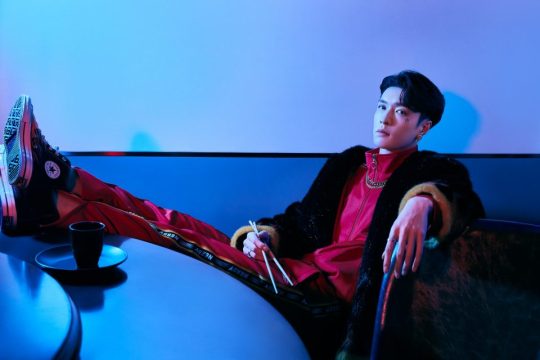
When I last spoke to Lay Zhang in 2018, he was embarking on an ambitious but daunting journey to bring Mandarin pop aka M-pop to the world. “I hope they think, ‘This artist isn’t bad,’” he had said with some trepidation in his voice. “I hope that they find my music special and maybe… they’ll want to learn more about me and Chinese music.” The singer-songwriter and producer aspired to create a true hybrid of traditional and modern music, a sound that defines our generation’s ability to package the past for the future.
Zhang, more commonly known by his stage name LAY, first debuted in 2012 as a member of world-famous K-pop group, EXO. Although he remains a member of the group, he’s spent the last couple of years in China to focus on a solo career and spotlight his own country’s burgeoning pop scene. It’s a process he kicked off with his second studio album Namanana in 2018, but he was still some time away from realizing his dream of pushing Chinese pop to a global stage.
It’s been nearly two years since our conversation for Rolling Stone India’s November 2018 cover feature, and any signs of trepidation are a thing of the past for LAY. We could chalk it up to him being two years older and wiser, but I’d like to think it’s because he kept his promise to bring M-pop to the world. If Namanana was just a dip in the pool of fusion experimentation, his latest studio album Lit is the deep dive.
“It is the evolution of M-pop for me,” LAY explains. “I wanted to take it to another level. When you hear the Chinese instruments, you know it is a different sound and vibe. The style is more pop, R&B, and hip-hop influenced with the Chinese instruments thoughtfully mixed in.” Comprising a total of 12 songs (all written and co-produced by LAY) Lit was released as two EPs instead of one LP; the first dropped in June while the second made its appearance in July. Nearly every track presents a fresh blend of traditional Chinese instruments like the hulusi, guzheng, flutes and gong with modern genres like trap, R&B, soul, hip-hop, future bass, dubstep and more. It’s a complex, refined and intricate record, utilizing production techniques that clearly outline LAY’s growth as an artist over the past two years. In retrospect, Namanana comes across a slightly more naive record–innocent and optimistic with a hope that international audiences would embrace both M-pop and LAY. Lit however seeks to take a different path and carves out the future LAY envisions with cool confidence and fearless production.
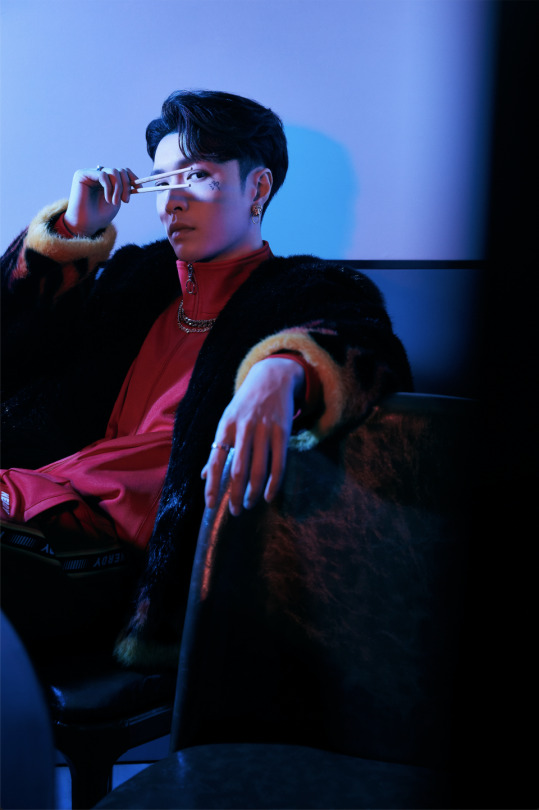
The tracks seesaw smoothly from Mandarin to English and back, with LAY showcasing both his vocal and rap skills. It’s an extremely powerful and expansive album, hair-raising at some moments due to the sheer surprises the artist packs in (at one point I hear what sounds like the tabla on “Call My Name” and it catches me totally off-guard.) Some of the collaborators on the record include big names like hip-hop hitmaker Murda Beatz, Grammy Award-winning producer Scott Storch, composer and producer Mitchell Owens and Grammy-nominated songwriter Mike Daley to name a few. For the title track “Lit,” LAY recruited China-native Anti-General who created a vicious and chilling trap/dubstep beat to complement lyrics that decimate LAY’s haters, gossip-mongers and the media, challenging them to come forward and take him down if they dare. The track sees the singer-songwriter rightfully crown himself a ‘king’ and leader in the music industry.
If that wasn’t enough, the music video for “Lit” is without a doubt one of the best released in 2020. With hundreds of extras, dancers, impeccable CGI and a compelling storyline, it’s more movie than music video, portraying LAY as a warrior king who refuses to be defeated. As executive producer, music director and co-choreographer on the project, LAY pays homage to China’s rich history and culture with tons of historical references and traditional symbolism. I tell him I particularly loved the symbolism of a white lotus emerging untouched and pure from the black ink–representing LAY’s rise in the industry–and he shares that the magnificent dragon that appears at the end was his personal favorite. “It was super important that we added it in,” he says. “It represents my wishes, aspirations and my relentless desire to always pursue perfection in the works that I create. I want my dancing, visuals, and music to be the very best it possibly can be.”
Lit is also thematically more complex and layered than any of LAY’s previous works, exploring concepts that revolve around confidence, love, fame, the media, success and more. “The album continues to explore chasing your dream,” the singer explains. “This time it’s about more personal things in my life. Like hometown, family and self-doubt.” A phonetic play on the word for lotus (莲 / lian) in Mandarin, ‘lit’ is a clever pun used to describe LAY’s similarity to a lotus and his prowess as a musician. He named the album after the lotus because of the symbolism of it growing and blossoming from dirt or mud. The lotus also continues the theme of duality with Lit’s two-part release, and, according to LAY’s team, “represents a new birth plus a new sound in the midst of all his past achievements.”
The album’s success more than speaks for itself– when the pre-order for Lit went live on China’s QQ Music streaming platform, nine certification records were instantly broken as it surpassed 1.5 million pre-orders within seven minutes and 19 seconds. This immediately pushed the EP to Number One on QQ Music’s daily and weekly album sales charts. Lit has also made LAY the best-selling artist in China in 2020, with a whopping 2.5 million records sold. It’s a testament to his drive and determination as an artist, the attention to detail and refusal to back down. The record’s international success was no less, hitting top 10 positions on iTunes charts across 32 countries, bagging 21 Number One spots and firmly cementing LAY’s position as the global megastar that he is.

Some things however, never change; brand deals, TV shows, multiple singles, EPs and collaborations keep his schedule completely booked and– just like back in 2018– it’s extremely tough to pin him down for a conversation. He’s currently in the middle of filming a reality show and has several other projects in the pipeline, but still makes the time to catch up and answer a few questions for Rolling Stone India. In this exclusive interview, LAY details his most successful record yet, the journey of finding the balance between East and West, dealing with the dark side of media attention and why the relationship between an artist and their fans needs to be a two-way street.
Congratulations on the release and tremendous success of Lit! It is an absolutely phenomenal record and I was thrilled to see you explore so many new streams of production. Can you tell me a little bit about the process of making this album and do you feel you met your own expectations for it?
For this album I wanted to mix in Chinese traditional instruments and tell Chinese stories. It is the evolution of M-pop for me. I wanted to take it to another level. When you hear the Chinese instruments you know it is a different sound and vibe. It is hard to say if I met my own expectations. As an artist you never ever feel your work is perfect. You can always find spots where you can improve. But I think what I was able to do with my team in the time we had was great.
You dove deeper into the fusion of tradition and modernity on this album than Namanana—there was a larger variety of Chinese instruments used as well as bilingual wordplay with language in the lyrics. In what ways do you feel you’ve evolved as a producer and songwriter since that album to Lit?
I am still trying to find the right style and combination to share my music and Chinese culture with the world. Lit was an example of my growth. I had this desire to include traditional stories and instruments from Chinese culture. Trying to find the balance with the Western music was challenging. I had to think and spend a lot of time arranging the chords around and fitting everything together. Also with this album I am talking about things in a more personal level and taking time to explain with more of an artistic style. I feel like I am growing up on this journey.
Lit is the first part of a series of EPs which will make a whole LP—why did you want to release it in this format and when did you begin working on the record?
I split it into two parts to give time to people to listen to it. I feel like if I released 12 songs at once, people may not give enough time to listen to each track. But when there are just six tracks each time, then it gives people time to listen more carefully. I started this project maybe early 2019.
The title track “Lit” is about your battle with the media, hateful netizens and malicious comments/rumors. Does it get easier over time to deal with this obsessive analysis of your life or does it never really ebb away?
It will always bother you, but over time you learn to deal with it. You focus on it less and less and back on what you love doing. When I make my music or learn dance or do anything I love, I kind of forget about it. Just focus on your goals and dreams and everything else becomes background noise.
The music for “Lit” is, in my opinion, the best of 2020 so far. Can you tell me a little about your role as the executive producer and music director on this project? How did the concept come about?
I was very involved in the project. I oversaw a lot of things that happened and discussed with almost everyone on the team on how to achieve my vision. When I was making the song I was thinking about how do we share Chinese culture. I thought filming in an ancient palace would catch people’s attention. It took off from there when discussing with the director. We started adding more and more elements of Chinese culture. We were trying to tell the story of Xiang Yu, a warlord who rebelled against the mighty Qin Dynasty but wasn’t able to conquer China. I’m Xiang Yu, but I’m trying to change my fate and succeed in my goal.
You incorporated Chinese Peking Opera in the music video version of the track and visual elements of Peking Opera in the album art for “Jade”–What was the motivation behind that decision and is there a particular story that the opera section references?
I wanted to bring people back in time to ancient China. I reference the traditional Chinese story of Xiang Yu and his love, Concubine Yu, so then I added in select passages from the Peking Opera Farewell My Concubine which tells their tragic story.
You displayed your incredible skills in dancing in this music video and you recently talked about how dancing was a way for you to show the audience who you are. Did you feel a sense of relief that the audience can see you or understand you a bit better after the release of “Lit”? Can the audience ever truly understand an artist?
It feels good to know people can see me and understand me more. I don’t think people can ever understand an artist completely. But they can relate to many things. I think that is a challenge for an artist to see how they can use their music to connect with people. It is a worthy challenge.
How do you hope that the artist you are today crafts the Lay Zhang of tomorrow?
I always believe in working hard and improving. I hope that the Lay Zhang of tomorrow continues to keep looking for ways to improve his art. I hope he never gives up his dreams.
Last time we spoke, we talked about Asian traditions represented in global mainstream pop culture. Now as you’ve grown as a megastar, you are one of the leading names in pop filling that space, bringing your heritage to the stage. Why is it important for our generation to see ourselves and our histories represented on these platforms by artists?
It is important for people to remember where they come from. They should know their own history and how their culture came to be. Also, it lets other people know another culture and have a deeper understanding. It can stop miscommunication and it helps people be closer to each other.
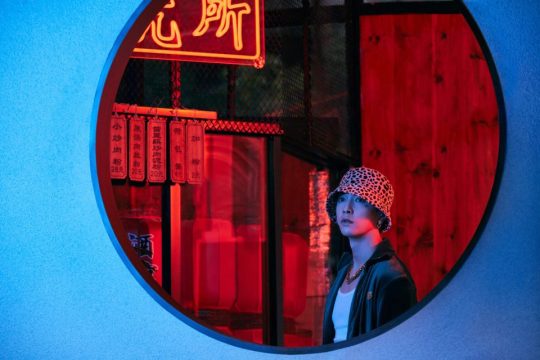
Why do fans need to see themselves in an artist? Does it work the same on the other side, do you as an artist see yourself in your fans?
I want fans to be able to relate with an artist. It is important for a fan to see themselves in artist and an artist to see themselves in a fan. When you can see each other you are able to understand each other better. You can connect with each other and really feel things.
I absolutely love the ‘Re-Reaction’ videos you have been doing for years and it means a lot to your fans that you take the time to do it. Why did you want to do this series and what does it mean to you to be able to connect with your fans like this and see them react to your work?
I am curious to know what fans and people think of my work. I want to know where I can improve. I want to keep growing as an artist. But also I want to let my fans know that I am reading their comments and I see everything they say.
Other than releasing more music, what are the rest of your plans for 2020? Do you have any film projects that you’re looking at taking up or are you planning on doing something completely different?
I am busy filming a TV drama and a few reality TV shows for the rest of 2020. A very busy schedule.”
Photo links: 1, 2, 3, 4
Credit: Rolling Stone India.
#EXO#EXO M#Lay#200819#exo im#exo m im#lay im#p:news#t:news#fs:rolling stone india#comeback:Obsession
67 notes
·
View notes
Text
Glenn Gaylord’s Capsules From The Bunker – Summer 2021 Lockdown Style
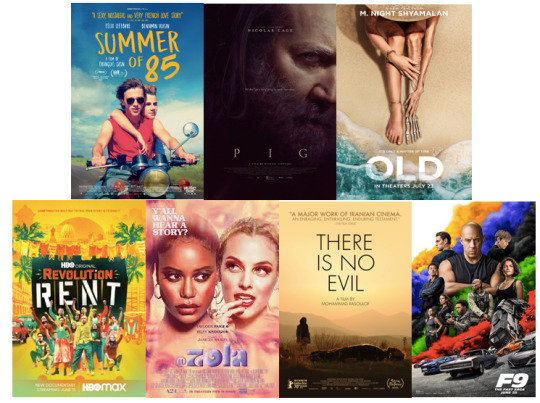
Like many of you, I’ve lost all concept of space and time during this lockdown era. I’d watch movie after movie, but somehow forget to write about them. I’d consume films for sustenance, but then I’d move on to the next task of cleaning a room, doing a crossword puzzle, or staring at my dog for hours on end. Thank goodness I have a few friends to have breakfast with every now and then, or else I’d have assumed I had been transported to a cabin in Montana. “Am I a film critic or a hermit?” I’d ask myself daily…that is, if I even understand what days are anymore. All of this is to say that I have a lot of catching up to do now that we’ve taken a baby step or two towards returning to some sense of normalcy. Wait a minute. What’s that? Highly transmissible variants? Back into the cave I go. While I still can, I’ve managed to blurt out a few capsule reviews of some films worth mentioning.

In Between Gays – Film Review: Summer Of 85 ★★★★
Prolific French filmmaker, François Ozon, has made a career out of finding dark crevices in the most unexpected of places. Here, with Summer Of 85, he tweaks this New Wave era gay romance just enough to upend our expectations. In pure Talented Mr. Ripley meets Call Me By Your Name meets Luca fashion, Ozon spins what could have been that sun-dappled, seaside summer that changed everything into a love that perhaps never was, zeroing in instead on a young man’s obsession for something unobtainable. Beautifully shot and acted, Ozon takes the story to more provocative places than you’d initially expect while still maintaining the boppy fizz of a great Cure song. Despite the mish mash of tones, the film has a pulse all of its own. It’ll make you swoon, pull the rug out from under you, and then make you wonder how he managed to quietly get a little twisted.
Summer Of 85 currently in select theaters, see official website for details. Released on DVD and BluRay August 17th.
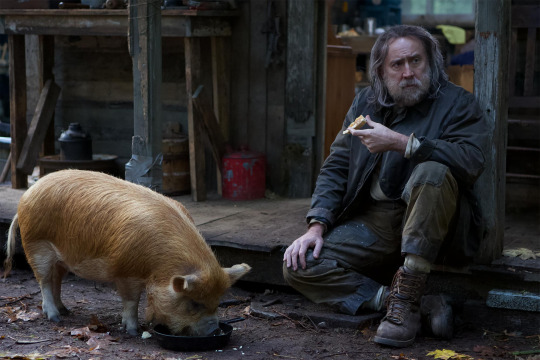
Truffle In Mind – Film Review: Pig ★★★★
Writer-director Michael Sarnoski makes an auspicious feature debut with the story of a man searching for his stolen truffle-hunting pig. Caked in dirt, blood and looking not so much like a homeless man but as a person who died inside a thousand times over, Nicholas Cage gives one of his best performances ever as a man who seeks the truth at all costs. He asks his only connection to the outside world, Amir, played wonderfully by Alex Wolff, to drive him through Portland’s dark underbelly to retrieve his pet companion.
Although the film takes us to a rather unbelievable “Fight Club” moment, it generally holds its mood with credibility. It’s a great calling card, not only for Sarnoski, but also for his talented cinematographer Patrick Scola, who brings a painterly quality to every single image. The film finds beauty in a bite of food, a breath of air, or simply the compassion between two main characters who have seemingly little in common. It’s a shame the trailer elicits laughs when Cage utters lines like, “Who has my pig?” Clearly they want to sell the actor’s neo-gonzo persona, but Cage brings so much depth and seriousness to this project, only raising his voice once. He deserves the highest praise for committing to such an oddly touching, gorgeously quiet story. At risk of sounding Dad-jokey, the only thing that hogs the scenery is his porcine friend.
Pig is in theaters now.
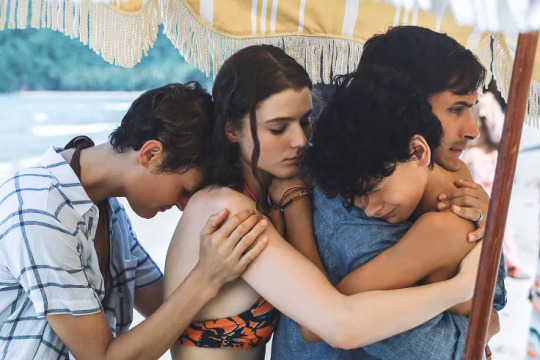
All Is Lost – Film Review: Old ★★
In 1999, M. Night Shyamalan made a great film, The Sixth Sense, and has been chasing that dragon ever since, often to diminishing returns. His films, however, often do well because he has great concepts, a keen eye for visuals and timing, yet things always seem to turn clunky and inane real fast. With Old, he continues down that path by giving us something compelling—a group of people on a beach who age quickly—and ruining it with dialogue seemingly written by an algorithm and rendered unintelligible much of the time, while the terrific cast seem to have no idea how to make Shyamalan’s words sound any better than a high school play. A couple of sequences did make me sit up and take notice, and he uses compositions and offscreen space well, but overall, Old plays like a stretched-out episode of Lost, and like that cool but overstuffed series, you’re not gonna get very good explanations as to what transpires. Sure, the big twist works well enough on some level, but it doesn’t save you from the discomfort of watching good actors flatline in more ways than one.
Old is currently in theaters nationally.

Hi Fidel-ity – Film Review: Revolution Rent ★★★1/2
Shot in 2014, Andy Señor Jr., who played Angel on Broadway along with a host of other credits, staged the classic musical Rent in Havana during a thaw in our relations with the Communist regime. He did so against the wishes of his Cuban family, who suffered under Castro and insisted his production would merely serve as a propaganda tool for the government. He plows ahead instead, capturing the months long process in a rather artless home movie style. The aesthetics don’t carry any weight here when you have such a compelling subject matter. Witnessing his actors struggling with their performances while also living in harsh conditions adds new layers to the late Jonathan Larson’s story of squatters in the age of AIDS.
With a limited talent pool, one of whom doesn’t feel comfortable with the gay subject matter and another who lives with HIV himself, Señor finds new connections to Larson’s material as well as an affection for his heritage. What we may have taken for granted here in the US in terms of sexuality and gender expression feels like a whole new experience when seen through a Cuban lens. Señor speaks out against the Castros with quick sequences showing moments of oppression, thus preventing this film from perpetuating the lies of its government. Instead, he gifts the people of this poor, struggling country with a real sense of community and its first burst of musical theater in ages. Sure he’s a privileged westerner who dangles hope in front of people only to return to his cushy life, but he does so with heart and good intentions. You end up loving and rooting for his cast in this moving, sweet documentary.
Revolution Rent is currently streaming on HBO Max.

Do The Hustlers – Film Review: Zola ★★★★
Call me wary when I went to see a movie based on a viral twitter thread and directed by Janicza Brava, whose Sundance Award-winning short, Gregory Go Boom, proved to be not only tone deaf but downright offensive towards people with disabilities. Her new film, Zola, excels however, in ways her prior work has not. Taylour Paige, a standout in Ma Rainey’s Black Bottom, plays the title character, a stripper who meets Stefani (Riley Keough) one night and is convinced to travel with her down to Florida where they can make a lot of money dancing all weekend. Things, however, do not go as planned, with Zola’s story escalating from one insane twist after another. Paige and Keough are outstanding, as are Nicholas Braun and Colman Domingo as their traveling companions. Jason Mitchell, so great in Straight Outta Compton and Mudbound, brings a wild, dangerous energy, something he shares with the film itself. It comes across as The Florida Project meets Hustlers, but with its own surreal, unexpected tone. I laughed out loud often, especially with Paige’s loopy reactions to her surroundings and the giddy, zippy energy on display. Zola chews you up, twerks on your face, and spits you out, exhausted yet anxious to see whatever this talented group of people will do next.
Zola is currently playing in select theaters and available on demand.
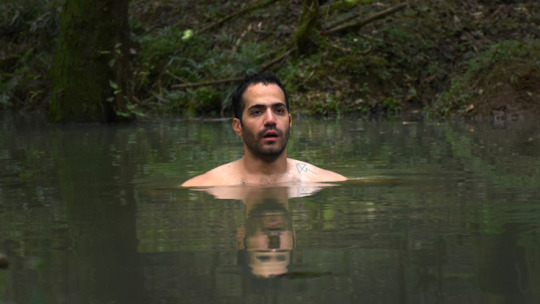
Banned On The Run – Film Review: There Is No Evil ★★★★
It’s impossible to review There Is No Evil without giving away its central premise, so I will avoid as much description as possible. Iranian filmmaker Mohammad Rasoulof has crafted a four-part anthology of sorts around an agonizing moral issue important to people worldwide. At the end of the first part, a stunning cut to an unforgettable visual reveals everything and allows you to watch the rest with informed eyes. Rasoulof seamlessly excels at different genres, from family drama, to action escape, to romance, weaving a tale of such depth and sorrow for its talented cast of characters.
The making of it proves as interesting at the film itself. Banned by the regime from producing feature films for two years and prohibited from traveling outside of Iran, Rasoulof, like any crafty filmmaker, came up with an ingenious plan. He slipped under the radar by calling these four short films, mostly shot in small towns far outside the reach of Tehran, and then had the final product smuggled out of the country. A filmmaker with such talent not only at telling stories, but the with ability to will his vision into existence against all odds, deserves the world’s attention.
There Is No Evil is available on DVD, BluRay and VOD now.

In Space No One Can Hear You Think – Film Review: F9: The Fast Saga ★★★
Considered review-proof, the Fast and the Furious franchise has ruled the box office for the past 20 years, so my calling its latest entry, F9: The Fast Saga, monumentally dumb will have zero influence on anyone’s decision to see it. We all know it’s big and stupid, as do the filmmakers. These films, deliver said stupid with such gusto, that you simply surrender and have a great time nonetheless. Nothing, however, prepared me, for this series to go all Moonraker, sending a car to a place no car has ever gone before. You’ll know it when you see it and probably say, “That’s ludicrous!” and also say, “That’s Ludacris!”
F9: The Fast Saga is currently playing on every screen on Earth and in select theaters throughout the universe.
4 notes
·
View notes
Text
How to Kill a Great Film in 2021
Good Films die every day in Hollywood. Contracts are written and thrown away, writers can be hired and fired as fast as old drafts can be thrown away and rewrites can be made days before production. And when that doesn’t stop a project from being a success, Producers can cut funding at the second to final lap around the track, locations can change, or in more recent cases, the entire world can change.
But let’s pretend this pandemic isn’t currently still in effect and fast forward to 2023, when cinemas are open again (sadly not for the Cinerama Dome) and a new movie is released once a week and regardless of how much we enjoy it, we get to talk about it. In this fantasy land, let’s talk about the 5 ways you can kill a good movie before, while, or after Production…
Relationship between Director and Producer
Whenever the release of a certain cut of a film that isn’t what the Director intended on releasing makes its way to Theatres, the thing that comes to most people’s minds is ‘Studio Interference’. If you’re an aspiring filmmaker, writer or just a fan of Cinema in general, you’ve heard all of your favourite Filmmakers talk about how much they hate their Producers, you hear horror stories about the un creative old rich man trying to be creative, forcing their bad ideas onto a project and thinking they have creative control because they’re funding it. And a lot of those stories are true, but is that really all? Are Studios really that mean? Even so, there was still a moment where the Producer sat down with the Director and said ‘I like your project, let’s make it.’ So they can’t be that terrible.
The truth to this problem lies at that meeting. Whatever the problem is that the studio, Director or Crew will find themselves knee deep in down the road, its source will be born on the desk where that meeting takes place. The Producer may have bad, unoriginal ideas and is just out to make bank on your project, and you may be an unknown indie-filmmaker just trying to find an outlet for your talented voice, but as different as these two forces are, they need each other to survive. A Producer needs a film to be successful in every theatre in the country in order to keep their business alive, and the Filmmaker needs to successfully capture their vision onto screen so they can share it with audiences around the globe, and that won’t happen without Studio Funding, and the Film won’t be made without a Filmmaker.
So what happens if you don’t get along, if the Producer changes their mind on the casting for the main character, or the third act of the script? Do you just say ‘Yes’ or ‘Fuck off!’? It’s up to the Filmmaker, but either answer won’t produce a good Film.
Another thing you’ll probably find in common with any Director whose movies have suffered a great deal of box office failure to what they claim is Studio interference, is that they hate producers, they say mean things about them during interviews and they establish bad relationships with Hollywood, and more often than not, their line up of upcoming projects grows thinner and thinner as the years go by.
A Filmmaker shouldn’t be surprised when they have a hard time getting their films made when this is how they treat the people funding them. As attached as you are to the movie you’re making, getting your film properly released involves your key role in a game that must be played, and played extremely well. If you have a disagreement with somebody, is the most wise next step to scream in their face? No. If you’d like somebody to see your point of view, it’s done only by a genuine back and forth dialogue, allowing both parties to level with one another, acknowledging each other’s perspectives and reaching a common goal they can both agree on.
A Filmmaker can still receive these requests and still say no and still have a great relationship with their Producers, it all comes down to the trust you establish with your collaborators, and yes, they are collaborators.
Not Getting Final Cut
Reason number two is exclusively caused by reason number 1; Getting the Final Cut for your film means that you alone have creative control over what the version of the movie you’ll one day be showing to audiences will look like. If you’re passionate about how you're going to eventually show your story to an audience, this is pretty important, as failure to do so will result in a version of your film reaching audiences that you did not play much of a role in.
Nobody wants somebody to take something they’ve made and turn it into something else entirely. If you’d like to see a prime example of this, watch Natural Born Killers. One of the most talked about Tarantino films isn’t even really a Tarantino film. ‘You don’t fuck with my material’, Quentin Tarantino told Oliver Stone when handing over his original script, to which Oliver and his team responded by taking his characters and plot and flipping it on its head, creating a new film that doesn’t even come close to resembling what Tarantino originally wrote, to which Tarantino responded by requesting his name be taken off of the writer’s credits.
How the Director Controls a Set.
When a Film is made, hundreds of people are involved other than the Filmmakers, Producers and their cast, there’s also a massive crew who must be considered. If you’re a Director, all of these people are working for you, which means you’re also responsible for feeding them, managing how fast or how slow they work, and their overall mindsets while making a movie and if you at any point assume that these decisions play a key role in the result of the final product, just walk into any retail store and see what happens when a Staff is treated poorly by its managers.
I’m glad I brought up Quentin Tarantino, because the Writer/Director has a very interesting rule on all of his sets: No Cellphones. At the door of a Tarantino set, a ‘Checkpoint Charlie’ will retrieve your device and give it back to you at the end of the day or in case of emergency. On Top of that, there are speakers planted on set, blasting music, chosen by Tarantino for the cast and crew to listen to while working. What results is a very chatty cast and crew, forced to engage each other in between takes or set ups, rehearsing lines and enjoying and embracing the atmosphere rather than trying to escape it. QT also has another very interesting rule: No Sleeping. But breaking this rule won’t result in death, only something worse… Floating around the internet is a photo of Brad Pitt and other Cast members of past Tarantino Films with a giant purple Dildo held against their sleeping faces on set. Morale is key.
Marketing
When shooting's wrapped, editing is almost complete, and everyone involved is very excited and thrilled that the release of their movie has met and maybe even exceeded expectations, now it’s time to release it. But to make sure that goes smoothly, you’ll need to advertise it so that people will know about it.
Which means it’s time to make your trailer. Making a trailer involves just as much writing as the birth of the Final Draft of your Screenplay.. The Filmmaker has a chance here to control how the future audience of their movie will perceive their story, how they absorb it and how they will use that information to make a decision on whether or not they’ll leave their house to go see it.
Here’s another place where studio interference may come into play. Say you’ve got a 3 hour long Western Drama that you’re trying to advertise, but the studio says that since this is a slightly more niche genre of cinema, and given the runtime it would be more wise to make the trailer feel rather fast paced and action packed, containing loud and fast music and sounds of gunshots and screaming! That way when people at home view it, they’ll feel excited, their hearts are racing because you've tapped into a very common human emotion that everybody on the planet could respond to: excitement.
Sure, this approach may sell a lot of seats on opening night, but what will the rest of opening weekend look like? Chances are, pretty blique. Because your Western Drama may indeed be a beautifully executed masterpiece filled with tension and tear jerkers, but the problem you’ll now face is that all of the people who went to see your movie left their houses because they’re big fans of high octane action films and that’s exactly what they were expecting when they came to see your movie. But that’s not what they got, so now they’re upset.
One thing that a lot of Producers today won’t admit is that a Film may not be for everybody, and that’s okay. Because rather than marketing to a broad selection of people who may or may not like your movie, your Audience will do a better job at championing your Film if you chose to only Market to the people who will want to go see it. Even if these numbers are fewer, if those people really enjoy your movie, they’ll do the rest of the marketing for you, which will get you an even bigger fanbase, which can maybe even turn into a cult following. The long term success of what you release will have a major effect on your ability to control future releases. The battles you fight now will win you the war of your career as a filmmaker.
As frustrating, controlling and sometimes crazy Hollywood can be to its Talent, at the end of the day, it's only an outlet for voices looking to speak out, it’s a malleable mechanism used by all of us, and without us it wouldn’t survive and vise versa, so we coexist. Any Film can be a great Film, but aspiring talent may not like to hear that talent will only put words on a page or a subject in frame, the true impact of what you create comes down to something as simple as knowing how to talk to people who aren’t like you, a method also referred to as ‘empathy.’
By Ezra Crittenden
#goodfilm#good movies#2021#kill#justiceleague#quentin tarantino#tarantino#zack snyder#drama#movies#movie#horror#comedy#thriller#romance#theatres#covid#success#opinion#nintendo direct#filmmaker#canada#america#usa
2 notes
·
View notes
Text
200819 How Lay Zhang Claimed The Throne of M-pop
When I last spoke to Lay Zhang in 2018, he was embarking on an ambitious but daunting journey to bring Mandarin pop aka M-pop to the world. “I hope they think, ‘This artist isn’t bad,’” he had said with some trepidation in his voice. “I hope that they find my music special and maybe… they’ll want to learn more about me and Chinese music.” The singer-songwriter and producer aspired to create a true hybrid of traditional and modern music, a sound that defines our generation’s ability to package the past for the future.
Zhang, more commonly known by his stage name LAY, first debuted in 2012 as a member of world-famous K-pop group, EXO. Although he remains a member of the group, he’s spent the last couple of years in China to focus on a solo career and spotlight his own country’s burgeoning pop scene. It’s a process he kicked off with his second studio album Namanana in 2018, but he was still some time away from realizing his dream of pushing Chinese pop to a global stage.
It’s been nearly two years since our conversation for Rolling Stone India’s November 2018 cover feature, and any signs of trepidation are a thing of the past for LAY. We could chalk it up to him being two years older and wiser, but I’d like to think it’s because he kept his promise to bring M-pop to the world. If Namanana was just a dip in the pool of fusion experimentation, his latest studio album Lit is the deep dive.
“It is the evolution of M-pop for me,” LAY explains. “I wanted to take it to another level. When you hear the Chinese instruments, you know it is a different sound and vibe. The style is more pop, R&B, and hip-hop influenced with the Chinese instruments thoughtfully mixed in.” Comprising a total of 12 songs (all written and co-produced by LAY) Lit was released as two EPs instead of one LP; the first dropped in June while the second made its appearance in July. Nearly every track presents a fresh blend of traditional Chinese instruments like the hulusi, guzheng, flutes and gong with modern genres like trap, R&B, soul, hip-hop, future bass, dubstep and more. It’s a complex, refined and intricate record, utilizing production techniques that clearly outline LAY’s growth as an artist over the past two years. In retrospect, Namanana comes across a slightly more naive record–innocent and optimistic with a hope that international audiences would embrace both M-pop and LAY. Lit however seeks to take a different path and carves out the future LAY envisions with cool confidence and fearless production.
“’Lit’ continues to explore chasing your dream. This time it’s about more personal things in my life. Like hometown, family and self-doubt.” Photo: Courtesy of Zhang Yixing Studio
The tracks seesaw smoothly from Mandarin to English and back, with LAY showcasing both his vocal and rap skills. It’s an extremely powerful and expansive album, hair-raising at some moments due to the sheer surprises the artist packs in (at one point I hear what sounds like the tabla on “Call My Name” and it catches me totally off-guard.) Some of the collaborators on the record include big names like hip-hop hitmaker Murda Beatz, Grammy Award-winning producer Scott Storch, composer and producer Mitchell Owens and Grammy-nominated songwriter Mike Daley to name a few. For the title track “Lit,” LAY recruited China-native Anti-General who created a vicious and chilling trap/dubstep beat to complement lyrics that decimate LAY’s haters, gossip-mongers and the media, challenging them to come forward and take him down if they dare. The track sees the singer-songwriter rightfully crown himself a ‘king’ and leader in the music industry.
If that wasn’t enough, the music video for “Lit” is without a doubt one of the best released in 2020. With hundreds of extras, dancers, impeccable CGI and a compelling storyline, it’s more movie than music video, portraying LAY as a warrior king who refuses to be defeated. As executive producer, music director and co-choreographer on the project, LAY pays homage to China’s rich history and culture with tons of historical references and traditional symbolism. I tell him I particularly loved the symbolism of a white lotus emerging untouched and pure from the black ink–representing LAY’s rise in the industry–and he shares that the magnificent dragon that appears at the end was his personal favorite. “It was super important that we added it in,” he says. “It represents my wishes, aspirations and my relentless desire to always pursue perfection in the works that I create. I want my dancing, visuals, and music to be the very best it possibly can be.”
Lit is also thematically more complex and layered than any of LAY’s previous works, exploring concepts that revolve around confidence, love, fame, the media, success and more. “The album continues to explore chasing your dream,” the singer explains. “This time it’s about more personal things in my life. Like hometown, family and self-doubt.” A phonetic play on the word for lotus (莲 / lian) in Mandarin, ‘lit’ is a clever pun used to describe LAY’s similarity to a lotus and his prowess as a musician. He named the album after the lotus because of the symbolism of it growing and blossoming from dirt or mud. The lotus also continues the theme of duality with Lit’s two-part release, and, according to LAY’s team, “represents a new birth plus a new sound in the midst of all his past achievements.”
The album’s success more than speaks for itself– when the pre-order for Lit went live on China’s QQ Music streaming platform, nine certification records were instantly broken as it surpassed 1.5 million pre-orders within seven minutes and 19 seconds. This immediately pushed the EP to Number One on QQ Music’s daily and weekly album sales charts. Lit has also made LAY the best-selling artist in China in 2020, with a whopping 2.5 million records sold. It’s a testament to his drive and determination as an artist, the attention to detail and refusal to back down. The record’s international success was no less, hitting top 10 positions on iTunes charts across 32 countries, bagging 21 Number One spots and firmly cementing LAY’s position as the global megastar that he is.
“I don’t think people can ever understand an artist completely. But they can relate to many things. I think that is a challenge for an artist to see how they can use their music to connect with people. It is a worthy challenge.” Photo: Courtesy of Zhang Yixing Studio
Some things however, never change; brand deals, TV shows, multiple singles, EPs and collaborations keep his schedule completely booked and– just like back in 2018– it’s extremely tough to pin him down for a conversation. He’s currently in the middle of filming a reality show and has several other projects in the pipeline, but still makes the time to catch up and answer a few questions for Rolling Stone India. In this exclusive interview, LAY details his most successful record yet, the journey of finding the balance between East and West, dealing with the dark side of media attention and why the relationship between an artist and their fans needs to be a two-way street.
Congratulations on the release and tremendous success of Lit! It is an absolutely phenomenal record and I was thrilled to see you explore so many new streams of production. Can you tell me a little bit about the process of making this album and do you feel you met your own expectations for it?
For this album I wanted to mix in Chinese traditional instruments and tell Chinese stories. It is the evolution of M-pop for me. I wanted to take it to another level. When you hear the Chinese instruments you know it is a different sound and vibe. It is hard to say if I met my own expectations. As an artist you never ever feel your work is perfect. You can always find spots where you can improve. But I think what I was able to do with my team in the time we had was great.
You dove deeper into the fusion of tradition and modernity on this album than Namanana—there was a larger variety of Chinese instruments used as well as bilingual wordplay with language in the lyrics. In what ways do you feel you’ve evolved as a producer and songwriter since that album to Lit?
I am still trying to find the right style and combination to share my music and Chinese culture with the world. Lit was an example of my growth. I had this desire to include traditional stories and instruments from Chinese culture. Trying to find the balance with the Western music was challenging. I had to think and spend a lot of time arranging the chords around and fitting everything together. Also with this album I am talking about things in a more personal level and taking time to explain with more of an artistic style. I feel like I am growing up on this journey.
Lit is the first part of a series of EPs which will make a whole LP—why did you want to release it in this format and when did you begin working on the record?
I split it into two parts to give time to people to listen to it. I feel like if I released 12 songs at once, people may not give enough time to listen to each track. But when there are just six tracks each time, then it gives people time to listen more carefully. I started this project maybe early 2019.
The title track “Lit” is about your battle with the media, hateful netizens and malicious comments/rumors. Does it get easier over time to deal with this obsessive analysis of your life or does it never really ebb away?
It will always bother you, but over time you learn to deal with it. You focus on it less and less and back on what you love doing. When I make my music or learn dance or do anything I love, I kind of forget about it. Just focus on your goals and dreams and everything else becomes background noise.
The music for “Lit” is, in my opinion, the best of 2020 so far. Can you tell me a little about your role as the executive producer and music director on this project? How did the concept come about?
I was very involved in the project. I oversaw a lot of things that happened and discussed with almost everyone on the team on how to achieve my vision. When I was making the song I was thinking about how do we share Chinese culture. I thought filming in an ancient palace would catch people’s attention. It took off from there when discussing with the director. We started adding more and more elements of Chinese culture. We were trying to tell the story of Xiang Yu, a warlord who rebelled against the mighty Qin Dynasty but wasn’t able to conquer China. I’m Xiang Yu, but I’m trying to change my fate and succeed in my goal.
You incorporated Chinese Peking Opera in the music video version of the track and visual elements of Peking Opera in the album art for “Jade”–What was the motivation behind that decision and is there a particular story that the opera section references?
I wanted to bring people back in time to ancient China. I reference the traditional Chinese story of Xiang Yu and his love, Concubine Yu, so then I added in select passages from the Peking Opera Farewell My Concubine which tells their tragic story.
You displayed your incredible skills in dancing in this music video and you recently talked about how dancing was a way for you to show the audience who you are. Did you feel a sense of relief that the audience can see you or understand you a bit better after the release of “Lit”? Can the audience ever truly understand an artist?
It feels good to know people can see me and understand me more. I don’t think people can ever understand an artist completely. But they can relate to many things. I think that is a challenge for an artist to see how they can use their music to connect with people. It is a worthy challenge.
How do you hope that the artist you are today crafts the Lay Zhang of tomorrow?
I always believe in working hard and improving. I hope that the Lay Zhang of tomorrow continues to keep looking for ways to improve his art. I hope he never gives up his dreams.
Last time we spoke, we talked about Asian traditions represented in global mainstream pop culture. Now as you’ve grown as a megastar, you are one of the leading names in pop filling that space, bringing your heritage to the stage. Why is it important for our generation to see ourselves and our histories represented on these platforms by artists?
It is important for people to remember where they come from. They should know their own history and how their culture came to be. Also, it lets other people know another culture and have a deeper understanding. It can stop miscommunication and it helps people be closer to each other.
“I want to keep growing as an artist. But also I want to let my fans know that I am reading their comments and I see everything they say.” Photo: Courtesy of Zhang Yixing Studio
Why do fans need to see themselves in an artist? Does it work the same on the other side, do you as an artist see yourself in your fans?
I want fans to be able to relate with an artist. It is important for a fan to see themselves in artist and an artist to see themselves in a fan. When you can see each other you are able to understand each other better. You can connect with each other and really feel things.
I absolutely love the ‘Re-Reaction’ videos you have been doing for years and it means a lot to your fans that you take the time to do it. Why did you want to do this series and what does it mean to you to be able to connect with your fans like this and see them react to your work?
I am curious to know what fans and people think of my work. I want to know where I can improve. I want to keep growing as an artist. But also I want to let my fans know that I am reading their comments and I see everything they say.
Other than releasing more music, what are the rest of your plans for 2020? Do you have any film projects that you’re looking at taking up or are you planning on doing something completely different?
I am busy filming a TV drama and a few reality TV shows for the rest of 2020. A very busy schedule.
Riddhi Chakraborty @ Rolling Stone India
22 notes
·
View notes